If you’re wondering what to eat in Japan, we’ve got you covered! We’ve put together a list of foods and drinks to try — from famous dishes to those you’ve never heard of. Plus, we’re going over important information everyone should know about eating in Japan.
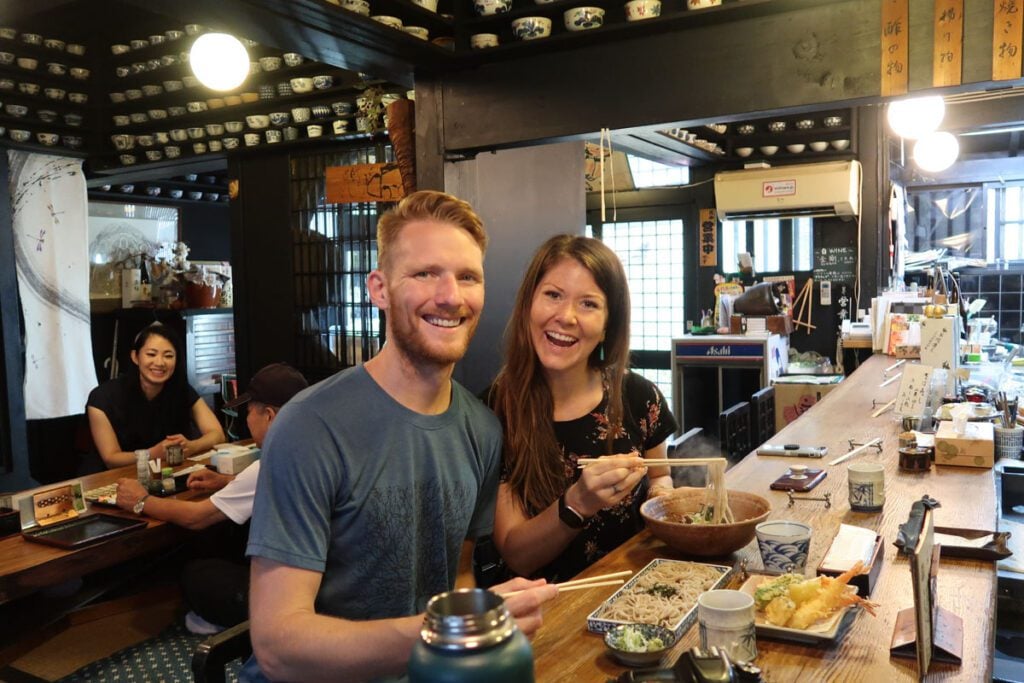
We love food. Sometimes I think we love it a little too much. And as we were planning our second trip to Japan, one of the things I was most excited about doing was eating as much Japanese food as I could!
But let’s back up… Before our first trip to Japan, our experience with Japanese cuisine was limited, to say the least. We’d had lots of sushi and miso soup over the years, but that was pretty much the extent of it.
When we arrived, we were overwhelmed by all of the options. Pair that with menus that had no English translation, and we were feeling a little lost. Okay, a lot lost.
So before our second trip to Japan, we came prepared. I spent a lot of time drooling behind a computer screen as I looked up popular Japanese food and compiled a list of all the foods I wanted to try in Japan.
I told Ben I was doing “research” (smart, huh?!).
And the result was a long checklist and coming to terms with the fact that we may not fit into our clothes at the end of the trip.
Pssst! Keep Reading, because we have a FREE gift for you that you’re not gonna want to miss!
Japan Food Guide
- Japanese food list
- What to eat in Japan
- Japanese cuisine glossary
- Food experiences in Japan
- Cost of food in Japan
- Vegetarian, gluten-free, & allergy info
- Manners in Japan
Guide to Japanese cuisine
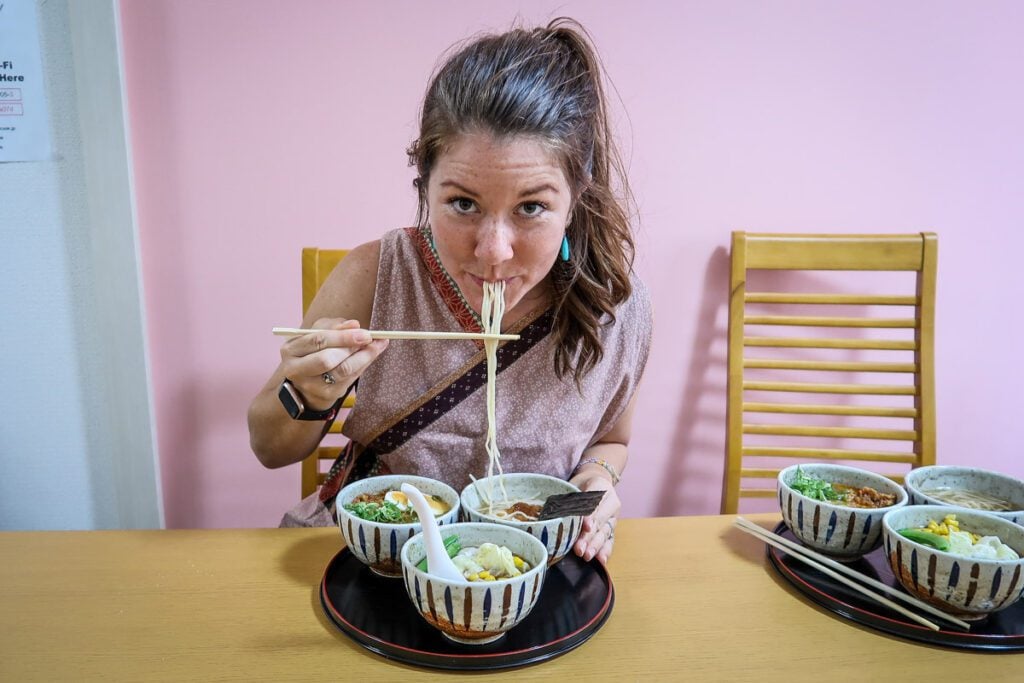
We’re pretty confident we are not the only ones overwhelmed (and a bit confused!) by Japanese cuisine, so we decided to put together a super informative article with all the stuff we wish we’d known before our first trip.
In this article, you’ll find a whole list of the best Japanese food, plus descriptions and photos! But that’s not all…
We’ve created a glossary of words to know about Japanese cuisine so you can read a menu even if it isn’t translated very well.
We’re also going over some important things to know for travelers who are vegetarian, gluten-free, or have other dietary restrictions. Plus, we’re sharing important Japanese manners, so you don’t embarrass yourself while eating. You’re welcome!
Just one more thing before we begin… You may want to read this article with a snack, because all these drool-worthy pictures and descriptions aren’t going to be easy to see on an empty stomach. You have been warned!
Japanese food list
Now that you know some handy words to help you understand Japanese cuisine, let’s start talking about all the delicious food you should try during your trip to Japan.
We have a FREE GIFT FOR YOU!
There are likely some Japanese dishes on this list that you’ve never heard of. To make this super easy, we created a PDF that you can download, print and take to Japan with you so you can remember all the tasty foods you want to try.
It’s totally free, so go ahead and print it off now so you can highlight foods you don’t want to miss as you read through the descriptions.
What to eat in Japan
Japanese cuisine is more than just sushi and ramen! We broke down this list of popular Japanese food you’ll want to try into different categories to help you narrow down your choices.
Alright, sit back and prepare to hear your stomach rumble…
Jump to your favorite section:
- Seafood
- Traditional Japanese food
- Noodles
- Japanese meals
- Snack foods & bar foods
- Sweets
- Trendy foods
- Location-dependent foods
- Beverages
Seafood
Being that Japan is an archipelago of nearly 7,000 islands, it’s no surprise that fish and seafood are a big part of the Japanese diet. If you are a fellow seafood lover, you’ll have plenty of dishes to try on your trip to Japan!
1. Unagi (freshwater eel)
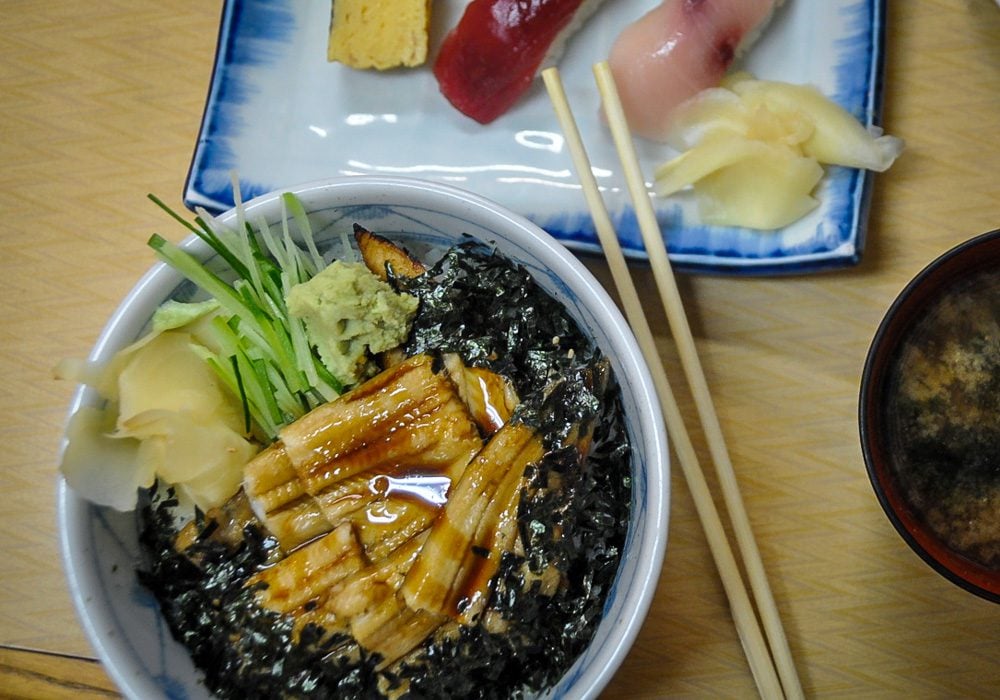
If this word brings to mind images of Ross on Friends with fingers to his temple, then we will get along well.
And since we’re friends now, I’m going to tell you that unagi is life-changing. Not the “state of total awareness” life-changing that Ross speaks of, but in the “I never thought eel could taste so good” way.
I’ve always been slightly creeped out by eels, and the prospect of eating one wasn’t too appetizing. But I’m so glad I did. It melts in your mouth and has a uniquely delicate flavor that is similar to fish.
Unagi is always cooked, as raw eel can be poisonous, and it’s typically served with a special eel sauce that is essentially a thick and sweetened soy sauce.
You can order unagi in a variety of dishes: in sushi, in unagi don (served on top a rice bowl), or simply grilled over hot coals.
Something to think about: Unagi tends to be on the more expensive side, and as we recently learned, the eel faming practices are not very sustainable or good for the environment. For these reasons, we’d recommend tasting unagi once or twice during your trip to Japan, but avoiding it too much more than that if possible.
Where to eat unagi: Most sushi restaurants will have it on the menu, and sometimes it’ll be served grilled at izakayas. There are also restaurants that specialize in unagi.
2. Uni (sea urchin)
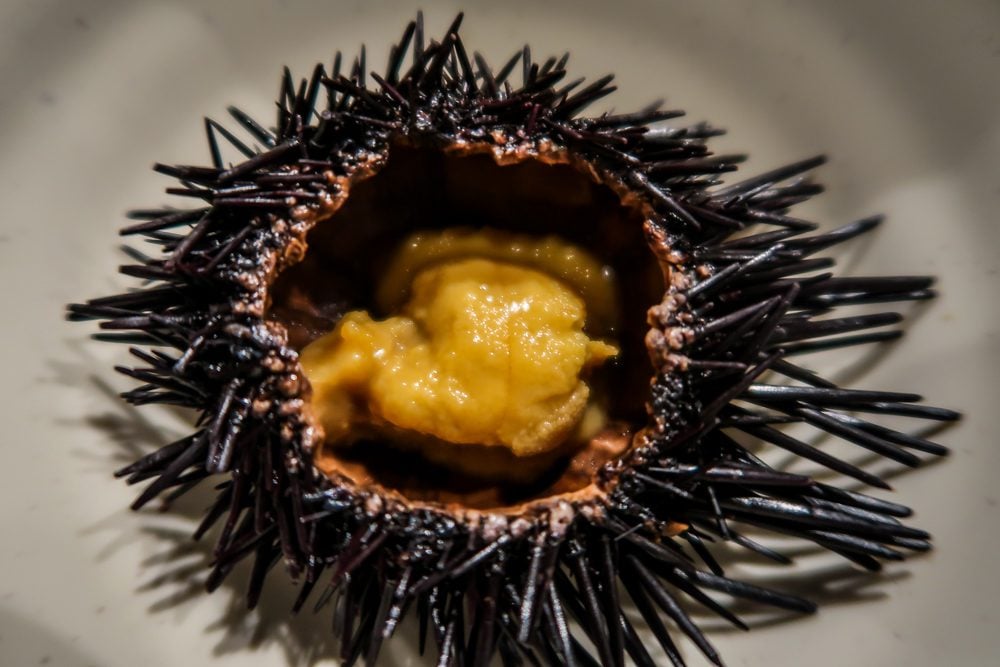
Let’s start by pronouncing this one correctly. Say it with me: oo-nee.
Good, now let’s get to what this weird-looking creature actually tastes like.
With a black, spiky exterior, this is not something I’d look at and think, “Yum, that looks tasty!” But once a sea urchin is cracked open, a golden… blob… is revealed.
While uni is certainly off-putting to some, it is a highly sought after delicacy, which is reflected in it’s high price. We gave it a shot while in Japan because we were very curious, and it tasted much different than we expected.
It had a creamy, almost custard-like texture, which sounds kind of unappetizing when describing seafood, but actually it was pretty nice. The uni had a stronger and more distinct flavor than I was expecting — kind of sweet and almost fruity (in my opinion!).
It is one of the more unique things I’ve ever tried, and there’s really nothing else I can compare it to, which is annoying as a reader, I’m sure (sorry!).
Tip: I’ve read that you want to be sure to get a fresh uni, as the texture starts to get mushy (and not very nice) when it sits out too long. It should not look slimy or wet, but instead should be firm and almost resemble the appearance of a tongue (I’m sorry for the not so appetizing comparison, but it’s true!).
Some people are obsessed with uni, and you can actually order a rice bowl topped only with these orangish sea urchins!
For me, one was enough to start with. I would definitely eat it again, but I don’t think I’ll ever be one to order a whole bowl.
Where to eat uni: Get them fresh at a fish market or from a sushi restaurant. We saw them on sale at the Kanazawa fish market for 700 yen each, as well as part of some of the sashimi bowls (which is how we tried ours).
3. Sashimi
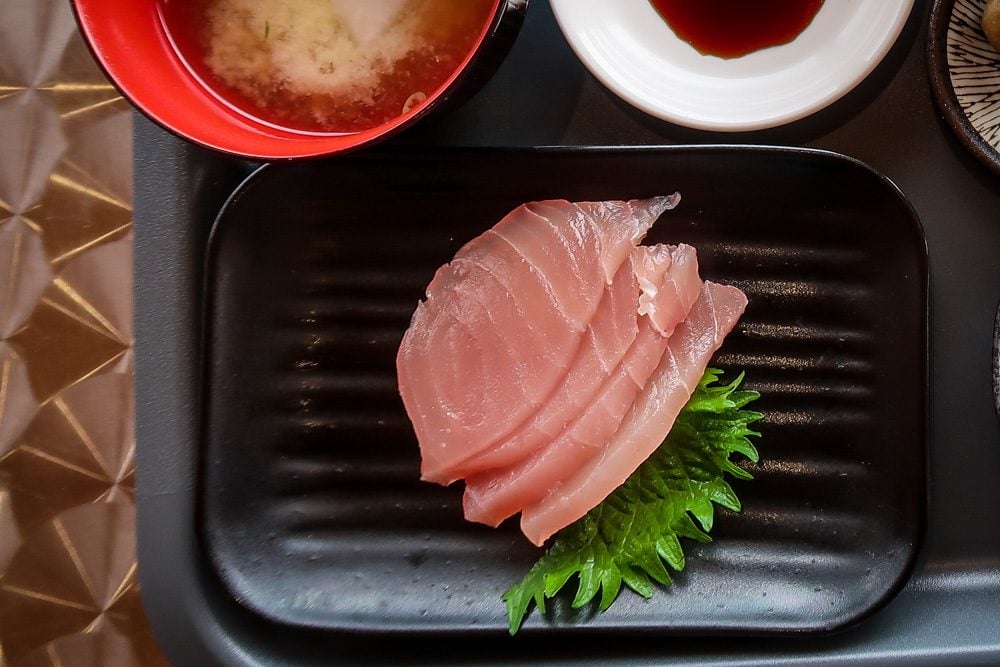
This Japanese delicacy is raw meat, sliced thinly and served with soy sauce for dipping.
While the most famous version is fish — like salmon or tuna — you can also find beef and even horse meat served as sashimi around the country.
Good to know: Sashimi is a good option for gluten-free travelers, though be sure to read the section on dietary restrictions below to understand what to look out for.
What is the difference between sushi and sashimi?
Sushi and sashimi are often confused; and while they are similar, there are some major differences.
- Sashimi = thinly sliced raw fish (can also include red meat) served without rice
- Sushi = rice mixed with vinegar and served with other ingredients, which can include raw fish (but doesn’t need to!)
4. Sushi
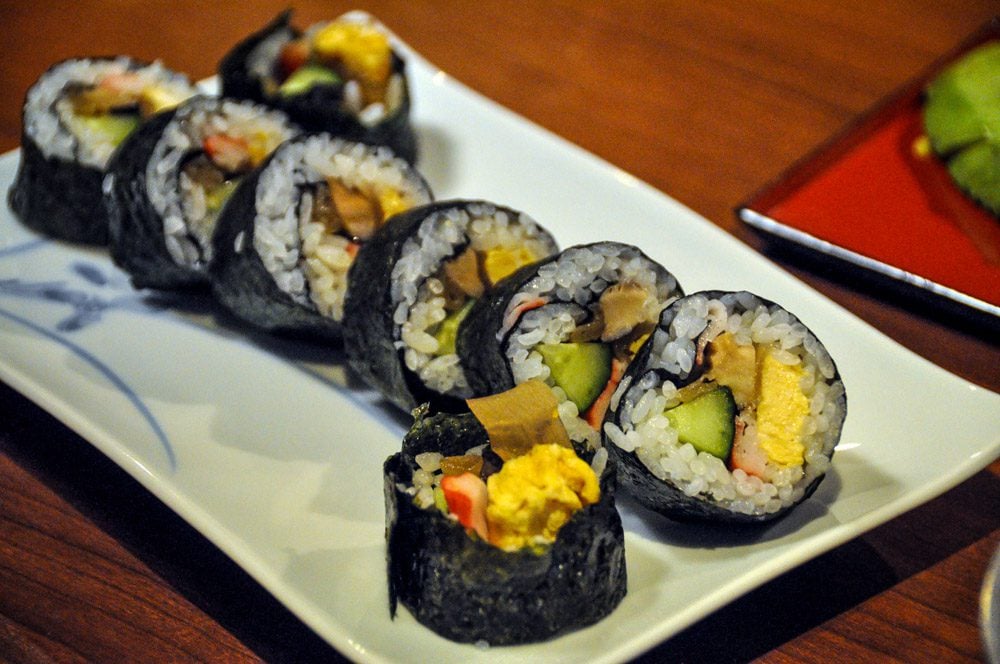
You just can’t go to Japan and not try sushi. It would be like going to Italy and not eating pasta! But before we delve in (this is long to be a long section!), let’s first get clear on what sushi is exactly, because it is often mistaken (I’m totally guilty!).
As defined above, sushi actually refers to vinegared rice served with other ingredients (I had no clue!). Sometimes sushi has raw fish, other times it does not.
Plus, sushi in Japan is undeniably fresher than what you’re likely used to. And I’m not just saying that… In the US and Europe, there are health codes that require all raw fish be frozen before being used in sushi or sashimi. This is done to kill potential parasites, but it does impact the texture and flavor of the fish.
In Japan, however, there are no such laws. Sushi chefs must go through years of intense training to be able to detect anything that could be wrong with a fish.
History of sushi (it’s super interesting!)
We’re about to blow your mind…
Even though we all think of Japan as the sushi capital of the world, this famous Japanese dish did not originate in Japan at all, but instead, in Southeast Asia.
Before the glorious invention of refrigerators, people needed a way to preserve fish. They found that mixing rice with vinegar and pressing raw pieces of fish on top did the trick.
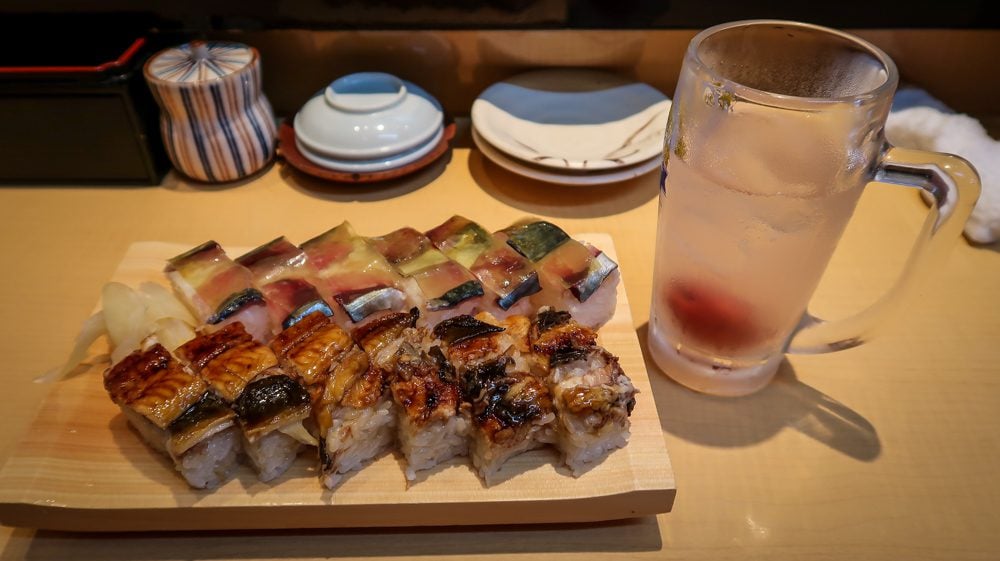
In the beginning, the rice was not eaten — it was only meant to be a way of keeping the fish fresh. But eventually, people decided that it was quite tasty paired with the fish!
This method spread to China, and eventually to Japan, where the modern-day concept of sushi took form in the mid-1800s.
→ Read next: We’ve rounded up all the things Japan is most famous for in a guide that’s also packed with practical travel tips. Plus, we’re sharing a few things we personally think Japan should be famous for, but most foreign tourists are surprised to know.
Types of sushi in Japan
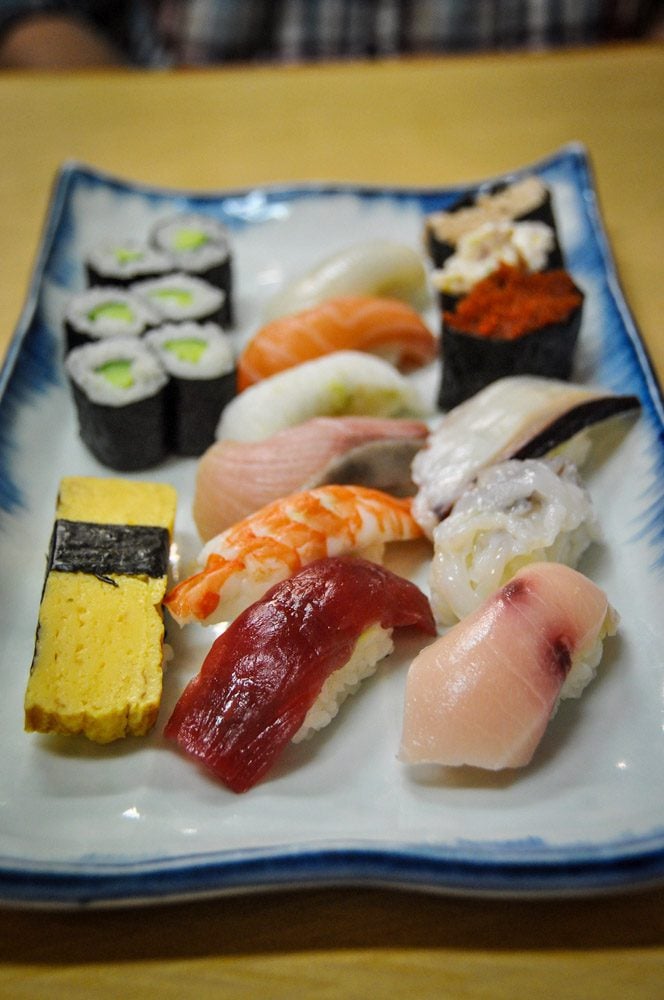
There are many different types of sushi, and it can be overwhelming if you’re unfamiliar with this dish.
Here are the basic types of sushi:
- Maki: the most common type of sushi, a seaweed sheet is wrapped around rice and fillings, before being sliced into disks.
- Uramaki: essentially the same as maki rolls, uramaki is made “inside out” with the rice on the outside.
- Nigiri: one ingredient (typically fish or prawn) is served atop sushi rice.
- If you dip it in soy sauce, it is proper etiquetteto dip the fish side so that the rice doesn’t fall apart.
- Eat these upside down, with the fish touching your tongue.
- Temaki: also called “hand rolls”, this type of sushi is made by rolling the fillings inside a nori (seaweed) sheet into a cone shape.
- Temaki should be eaten immediately after it’s made so the nori is still crisp.
- This type of roll can be eaten with your hands and it is difficult to share.
Other sushi types to know
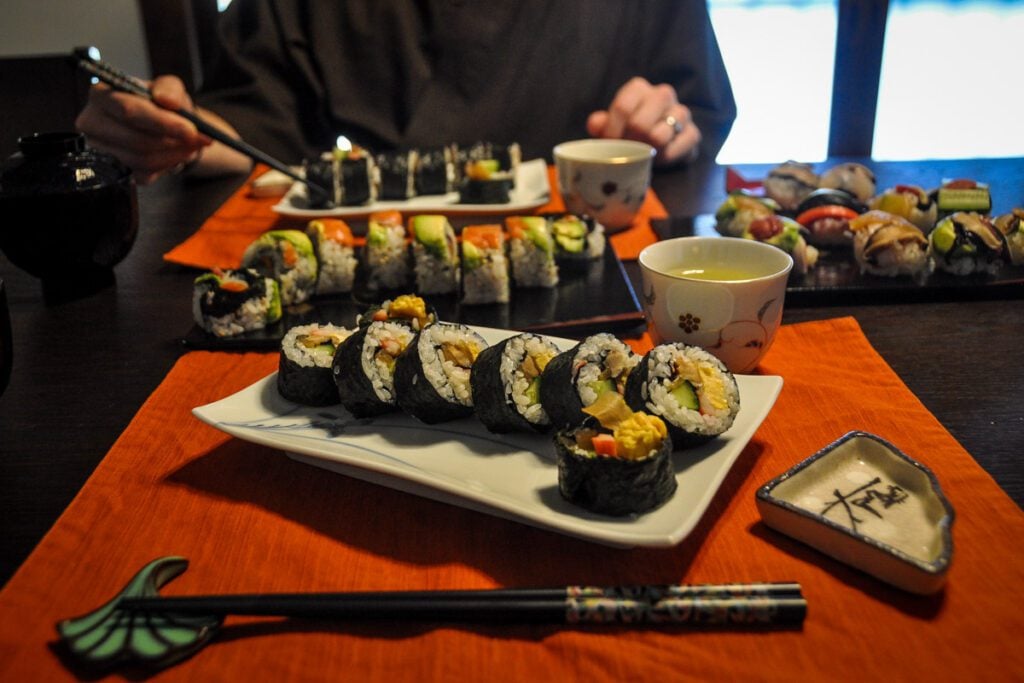
- Oshizushi: pressed sushi made by layering rice and thinly sliced fish in a mold. It is pressed down to create tightly packed sushi, and mimics the origins of this dish (read the history section above!).
- Omakase: meaning “I’ll leave it up to you,” allows the sushi chef to choose your order and often grants you excellent service and a unique dining experience. But here are a couple things to know about omakase:
- This is only an option in sushi restaurants that have lots of fresh ingredients (like you’d find at a fish market).
- Sit at the bar near the chef, if possible.
- Don’t order omakase if you are a picky eater or have dietary restrictions.
- You won’t know the price until the bill comes, so this may not be a great idea for budget travelers.
- Vegetarian sushi: As we explained above, sushi doesn’t just mean fish and rice. If you are vegetarian or vegan, there are several different types of ingredients you can order in your roll no matter what Japanese restaurant you’re at. Here are a few:
- Nigiri with shiitake, avocado (in season), or tamago (slightly sweet omelette; ask for it to be made without dashi)
- Maki
- Kappa maki: cucumber roll
- Shinko maki: pickled vegetables
- Ume/Umeboshi maki: pickled plums
Sushi Experiences in Japan
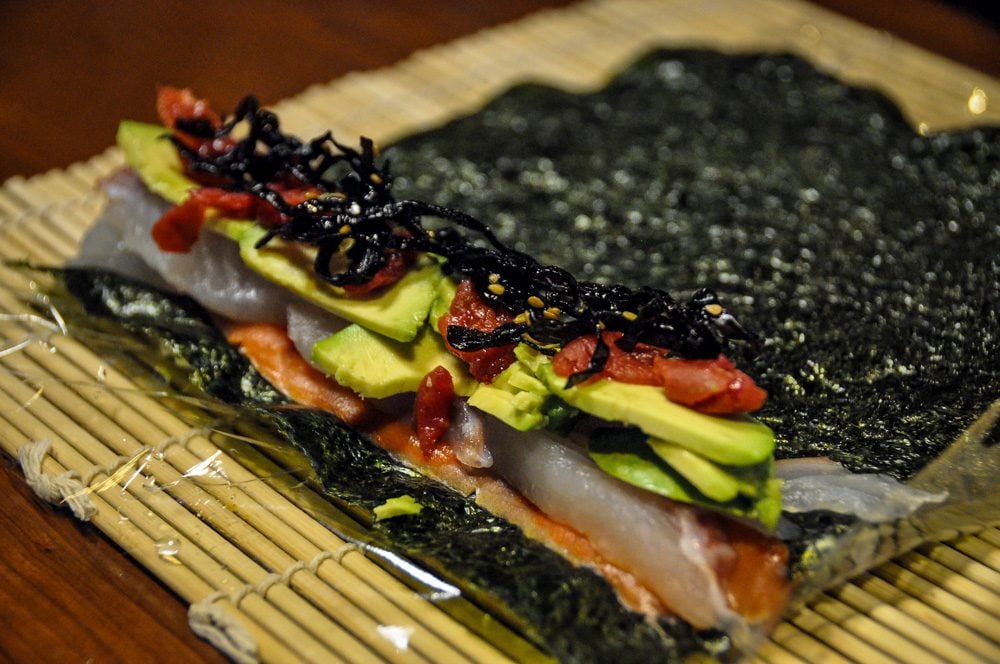
Compared to other meals in Japan, sushi is not all that expensive. Plus, there are options suitable for vegetarians and vegans. So order it often!
- Sushi-making Cooking Class: If you want to do a little DIY sushi, Japan is the perfect place to learn the techniques. We took a sushi-making class and had a great time learning about the ingredients used (many of which we never would have guessed!).
- Conveyor Belt Restaurant: This is where you can pick each piece off the moving counter beside you. These restaurants are typically a good budget option!
- Kombini (convenience store) sushi: Another good options for travelers on a budget, convenience stores in Japan are known for having ready-made sushi that is actually pretty damn good! And definitely not as sketchy as it sounds, I promise.
- Famous fish markets: If you’re a sushi lover, you won’t want to miss the fish markets around the country. This is where early morning auctions for the catch of the day take place. But even if you don’t want to get up before the sun to see this, you can enjoy a sushi breakfast (yep, breakfast!) made from fish that was swimming just hours before. Can’t get more fresh than that!
- There are fish markets around the country, but the most famous are in Tokyo:
- Tsukiji Market, which is the old (and more authentic feeling) market.
- Toyosu Market is where auctions now take place. It is super clean and modern, but lacks the old school character of the former.
- Kanazawa is a seaside town with a famous fish market as well!
- There are fish markets around the country, but the most famous are in Tokyo:
5. Kaisendon
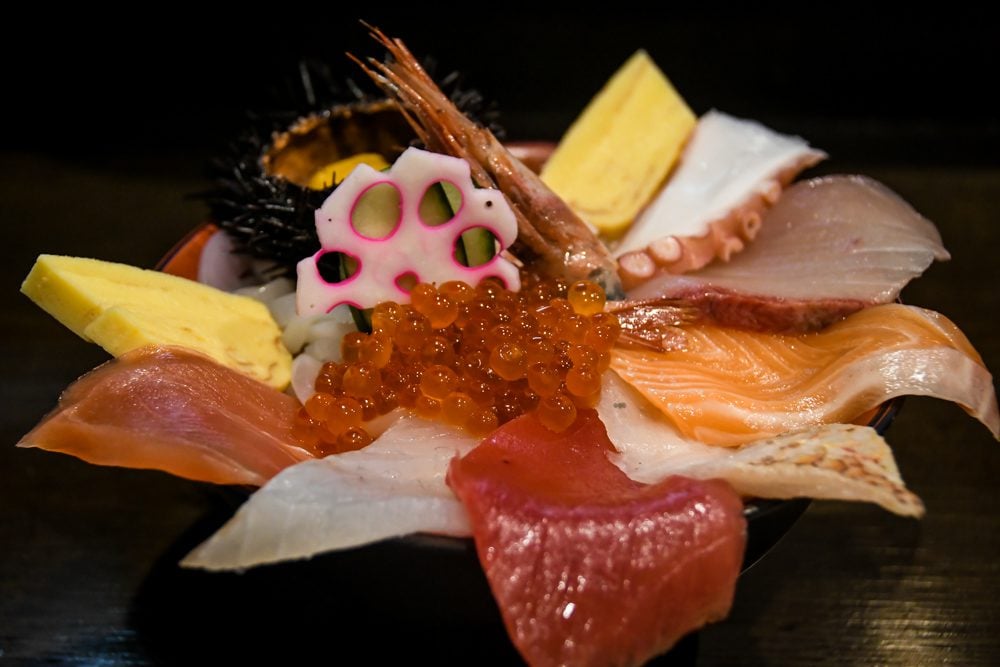
This is a popular Japanese dish that starts with a bowl of sushi rice (short-grained rice mixed with a bit of rice vinegar, sugar and salt), and is topped with fresh sashimi.
There are typically different options available, but if you are adventurous, order the bowl with a little bit of everything: uni, salmon roe, prawn, and raw fish.
Where to eat Kaisendon: This is a popular meal for lunch, and is best eaten at a restaurant near a fish market. We tried ours at the Kanazawa fish market, and asked ahead of time if we could split one bowl (since they are large and expensive).
Note: Typically if a restaurant is busy, it’s considered rude to split, as you’re taking up valuable seats. However, we arrived between lunch and dinner and there were plenty of seats open so the chefs said it was fine.
Traditional Japanese food
Japanese cuisines is more than just sushi… much, much more. Below are some “classic” Japanese dishes that you’ll be able to find around the country.
6. Tonkatsu
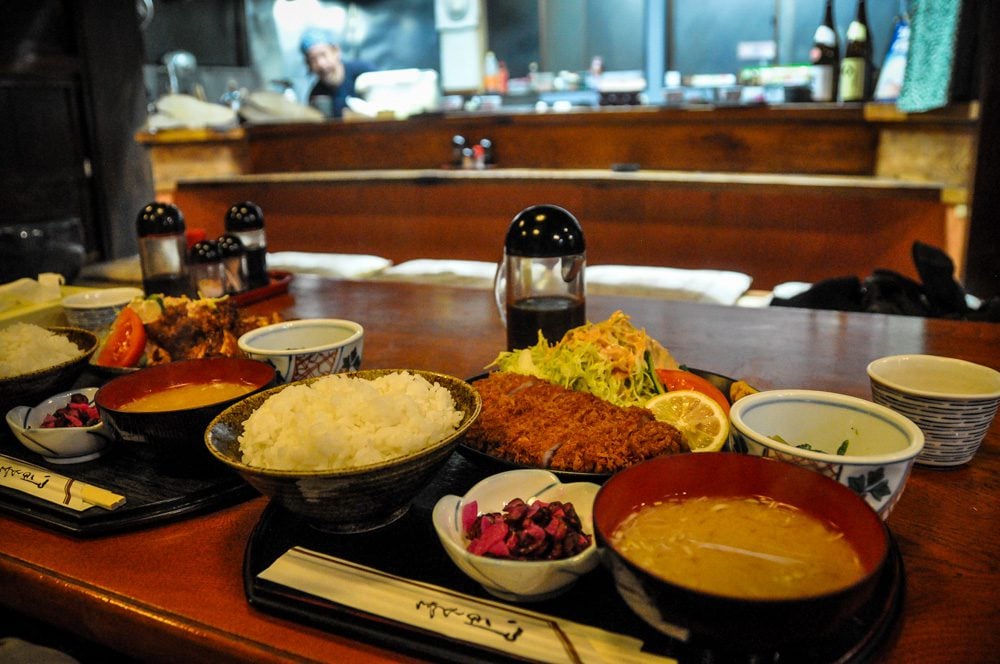
Truth be told, I’m really not a pork person. I’m also not really a fan of deep fried things. So there’s two reasons I thought I wouldn’t like tonkatsu — breaded, deep-fried pork cutlet.
This classic Japanese comfort food surprised me though. The first time Ben ordered it I found myself stealing bite after bite. Hey, I shared my meal too!
Traditionally, tonkatsu is served with a rich Worcestershire-based sauce, rice, shredded cabbage, and miso soup. This breaded pork cutlet is also a common filling in convenience store sandwiches and can be a component of curries (see below).
Note: Since the spelling is so similar, it’s easy to confuse this dish with tonkotsu (pork bone broth ramen).
7. Japanese curry
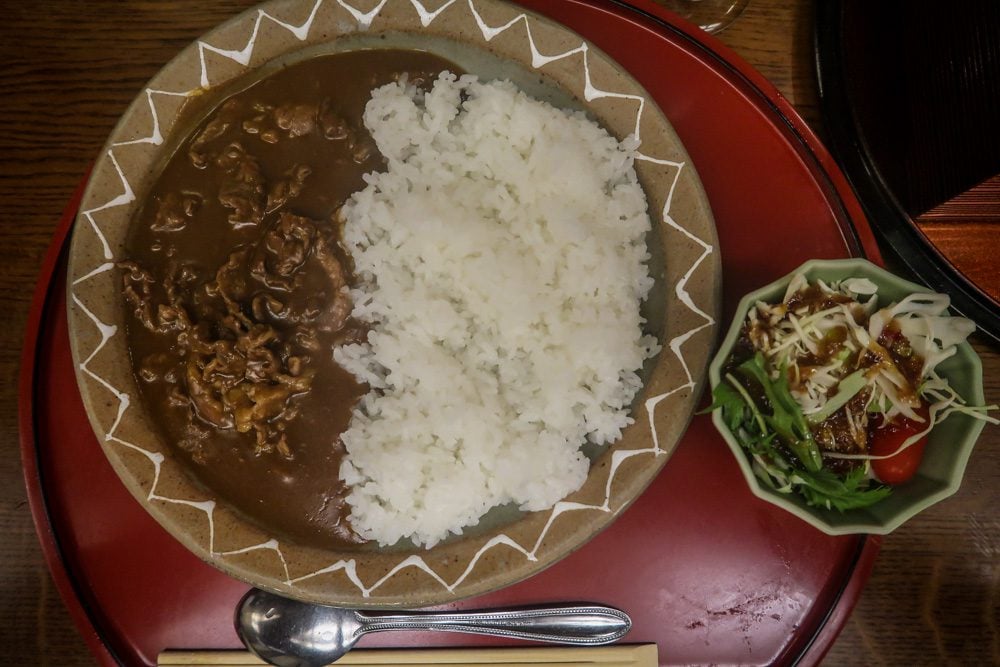
Curry? In Japan? Say what?! If you’re confused about this one, you’re not alone.
You know that game “telephone” you used to play as a child? Well, Japanese curry is kind of like that.
Curry was actually introduced to Japan by the British during the Meiji era (1868–1912), a time during which India was under British colonial rule. This means Japan got the British version of curry, which was quite different than the original.
And of course the Japanese put their own spin on the dish, so it is a far cry from the Indian version. However, it’s still super tasty and well worth a try during your trip to Japan.
Called “karē” (sounds like curry), the Japanese version of dish will consist of a mixture of carrots, potatoes, onions, and beef or pork, with a dark and thick gravy-like sauce. It’s super rich and hearty, and is perfect on a cold winter day.
Versions of Japanese curry
- curry rice
- curry noodles (udon)
- curry-filled pastries
With each type of curry dish, you can choose different options, like beef (pictured above), pork cutlet, or vegetarian, to name just a couple of varieties.
Curry has gained popularity in Japan over the years, and today curry is a more popular dish amongst Japanese people than tempura and sushi. Is your mind blown too?!
Where to eat curry in Japan
CoCo Ichibanya has been recognized as the largest curry chain in the world, and is a good place to try this staple dish. Plus, they have decent vegetarian options!
This is crazy: In addition to more than 1,200 shops in Japan, CoCo Ichi (for short) has locations in the USA, other countries in Asia, and get this — they are opening their first restaurant in India in 2020 with hopes of expanding. It’s kind of a strange cycle when you think about it: India—Britain—Japan and back to India…
Tip: For a non-chain version, simply type “curry” into Google Maps and you’ll likely find lots of options around you!
- Te Spices Curry, Osaka: We liked this cute little curry shop (they don’t have an English menu, but the owner is helpful).
- Curry Yakumido: Looks like another great curry option in Osaka.
8. Wagyu
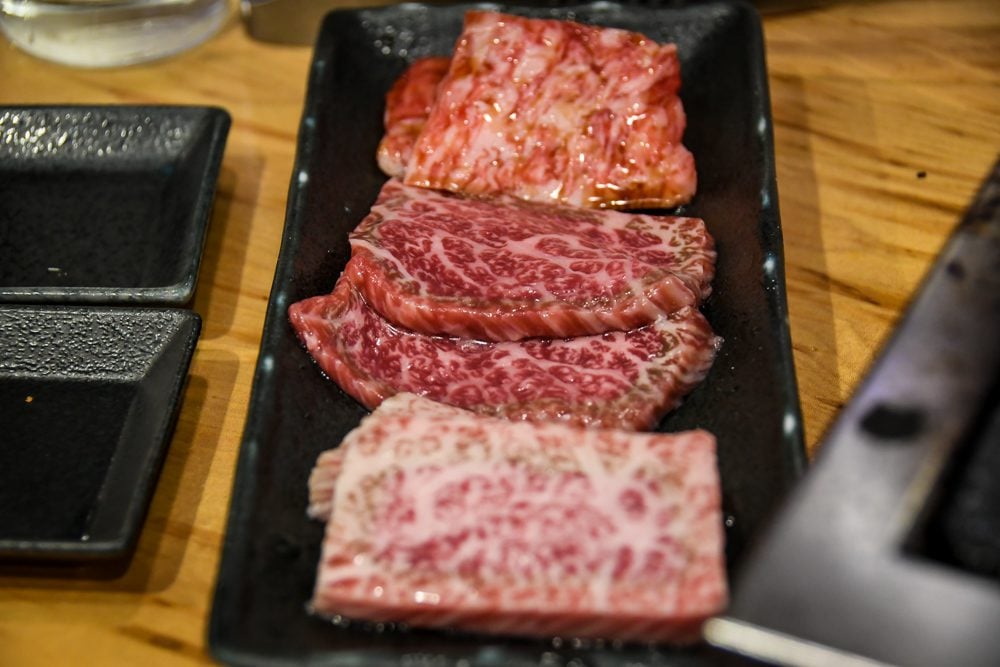
The word wagyu refers to any breed of Japanese beef cattle. If you break down the word itself, ‘wa’ means Japanese and ‘gyu’ translated to cow.
Wagyu meat is known for its distinct marbling and tenderness, making it not only delicious, but typically quite expensive.
Note: What’s the difference between Kobe and Wagyu? Kobe beef is type of Wagyu, and refers to cattle raised in the Hyogo prefecture (where Kyoto is located) under very exclusive conditions. It is highly regulated by the government, and fewer than 4,000 cattle meet the requirements to be called “Kobe beef” each year. So it makes sense that this strain of wagyu is among the most expensive.
When you order wagyu, you’ll typically need to select the grade of meat, which can be confusing for a first-timer.
Here’s the most basic description: You will choose the Yield Grade (aka how much quality meat the cow produces) A, B, or C, with A being the best; and a Quality Grade 1-5, with 5 being the best. So A5 wagyu is the highest quality.
This article breaks down the grading system in much further detail.
Where to eat wagyu: You can try wagyu in a variety of ways, from a steak to small slices you grill yourself in a Yakiniku (bbq) restaurant. In some parts of the countryside where wagyu is raised, you can even find wagyu sashimi, where the meat is served raw over a small portion of rice.
Our recommendation: If you’re in Tokyo and are looking to try wagyu on a budget, we highly recommend Jiromaru Akihabara which is a casual establishment where you stand along a service bar where the fresh meat is chilled.
You can select meat yourself by grade, or you can have the chefs choose their selection of 5 different cuts and grades for 1,500 yen (not too bad!). You’ll have a personal grill where you can cook up your meat and vegetables (like shiitake and green onions) to perfection before dipping in the assortment of sauces and spices provided.
9. Tempura
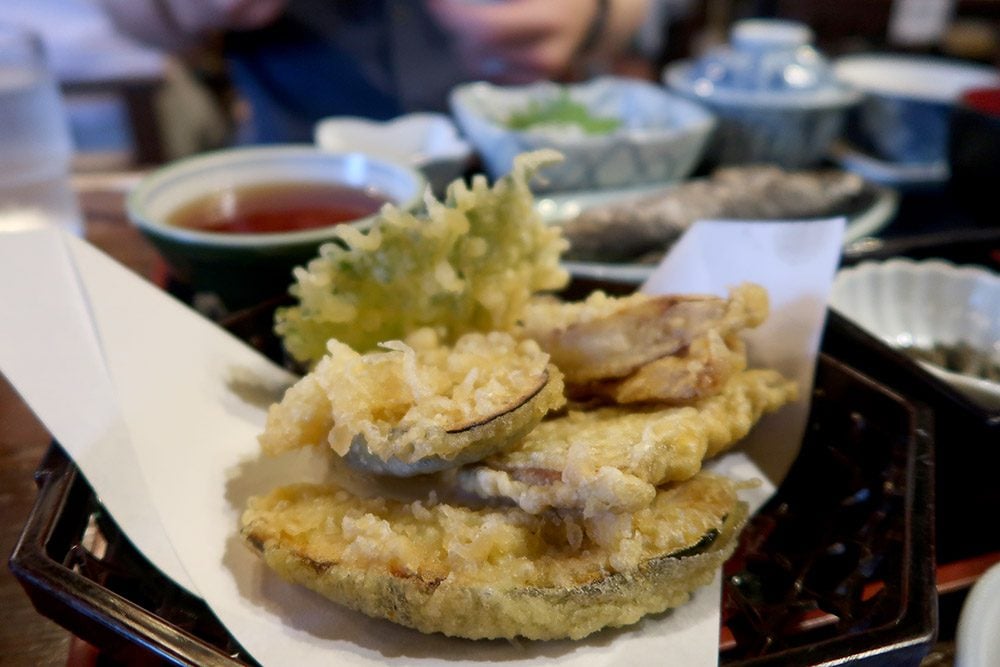
Tempura is a method of cooking in which individual pieces of seafood (like shrimp) or vegetables are battered and deep fried, resulting in a light and crispy bite.
Typically, you’ll be served a variety of items — sweet potato, eggplant, mushrooms, shiso leaf, lotus root, prawn — and a light and flavorful dipping sauce called tentsuyu, which is made from soy sauce, mirin, and dashi.
Note for vegetarians: With the exception of shrimp, most of the ingredients in tempura are vegetables, making this dish a good option. However, the traditional dipping sauce (tentsuyu) is made with dashi, which is a stock made from dried fish. Instead, use soy sauce for dipping.
10. Miso soup
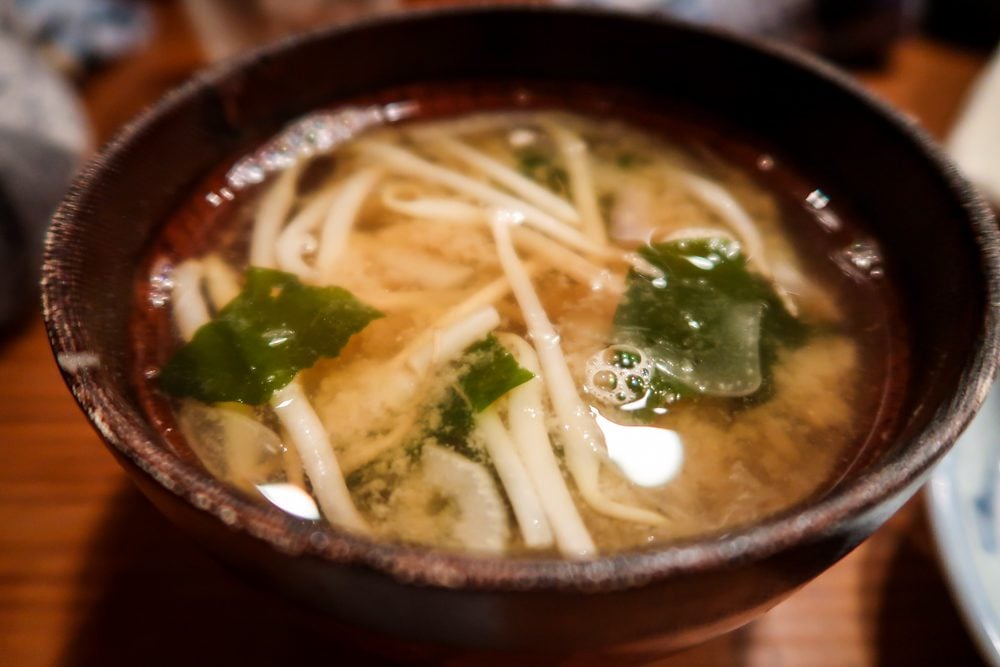
If you frequent sushi restaurants at home, you’ll likely be familiar with this traditional Japanese soup. This light and brothy soup is served in addition to a larger meal, and most Japanese people eat miso soup at least once a day.
The broth for this popular soup is made when miso paste is added to dashi (stock made with dried fish).
Depending on the region, different ingredients can be added to the soup. Popular additions are tofu, seaweed, green onion, bean sprouts, and daikon radish; but toppings are typically light, as the focus is on the broth.
11. Okonomiyaki
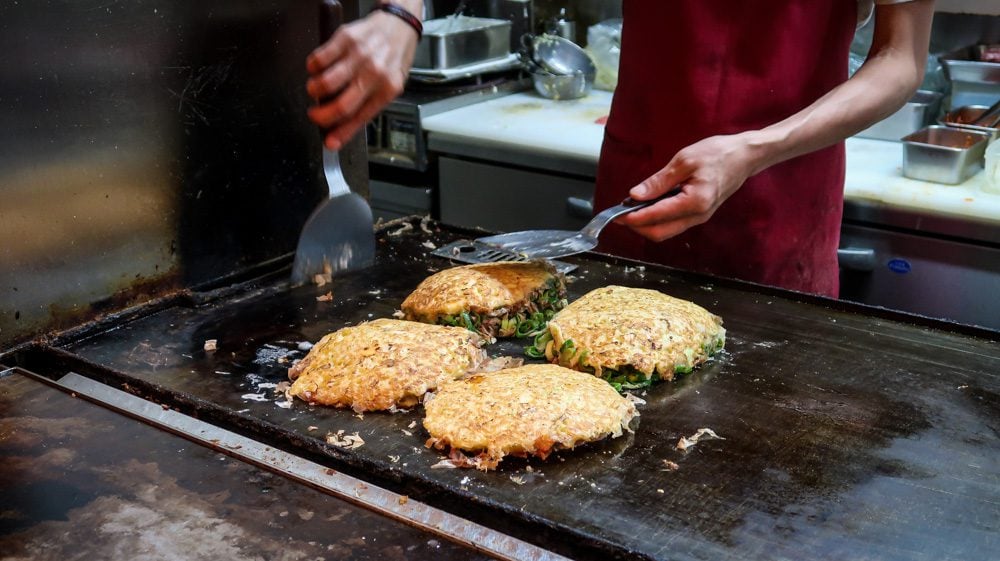
Okonomi meaning “what you like” and yaki meaning “grilled”, this savory pancake is literally, well, “grilled how you like”.
The batter is typically made from a combination of wheat flour, grated yam, eggs, and dashi (stock made with dried fish). Popular toppings include cabbage, pork belly and green onions, but there is a ton of variety, including all types of seafood, vegetables, and cheese.
You can choose ingredients to your liking, earning this round, topping-heavy dish the popular nickname “Japanese pizza”.
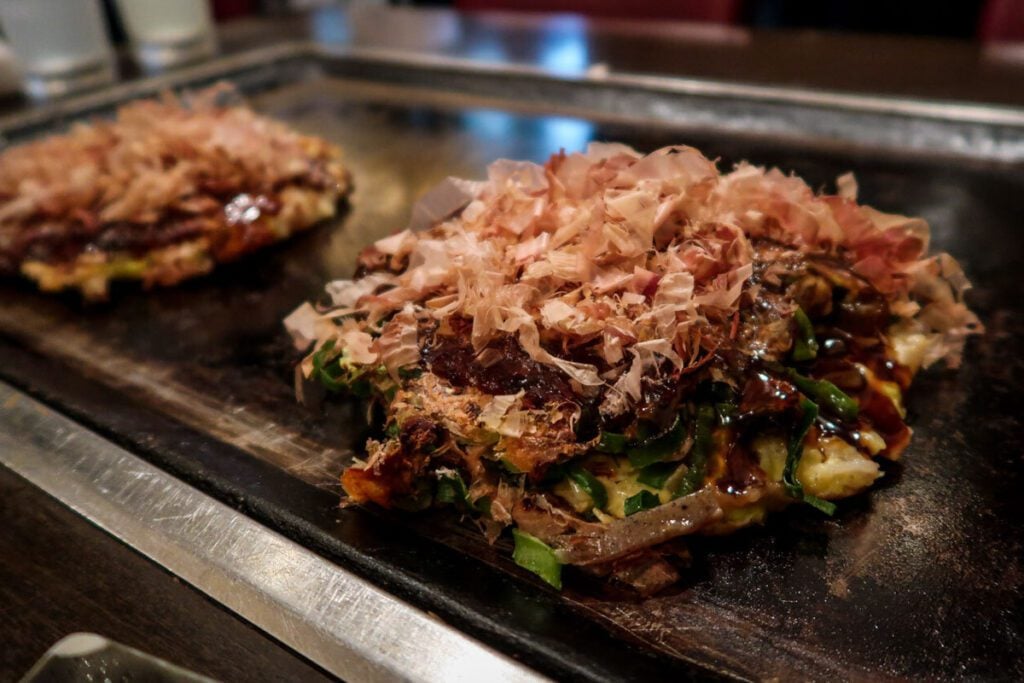
At some restaurants, you’ll be seated in front of a hotplate where you can cook the okonomiyaki yourself.
The finished dish is typically served with mayo and a special okonomiyaki sauce (like a thicker and sweeter version of Worcestershire), seaweed flakes, bonito flakes (dried fish), and pickled ginger.
Where to eat okonomiyaki: You can find okonomiyaki throughout the country, but if you want the traditional version, head to Osaka where the dish is said to have originated. Hiroshima has its own style of okonomiyaki, in which the ingredients are layered instead of mixed, and there is much more cabbage included.
12. Gyudon
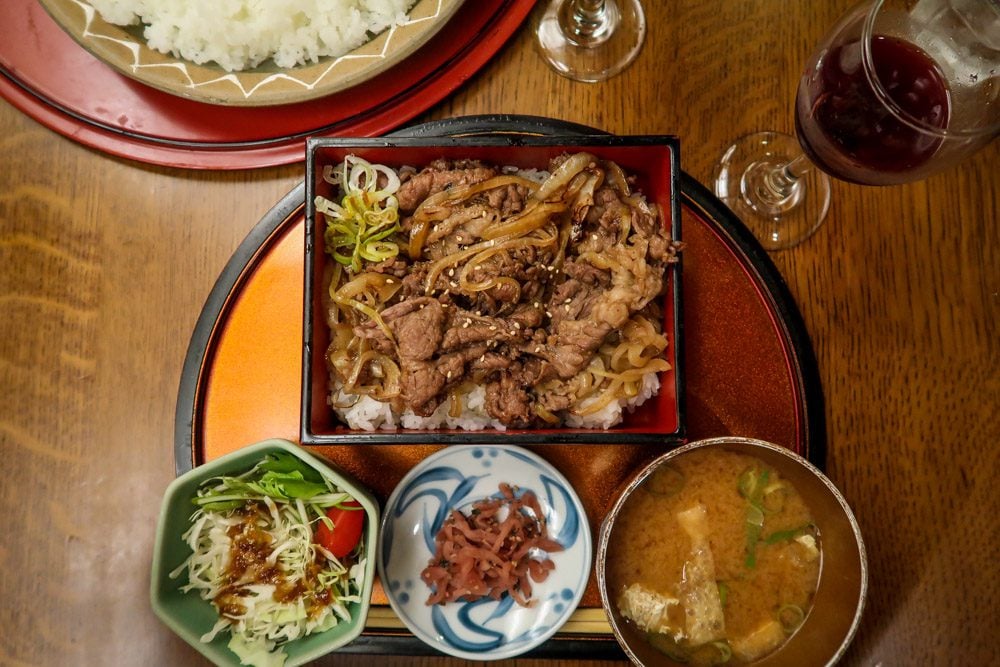
Translating to “beef bowl” this hearty combination of rice and thinly sliced beef simmered with onion, and a lightly sweet soy sauce-based marinade is oh so satisfying, and reminiscent of the Korean staple, bulgogi.
Attention all budget travelers: There are many fast food chains throughout the country that specialize in gyudon, making it a quick and affordable meal option!
Where to eat gyudon: Fast food chains that specialize in gyudon to look out for:
- Sukiya
- Yoshinoya
- Matsuya
13. Lotus root
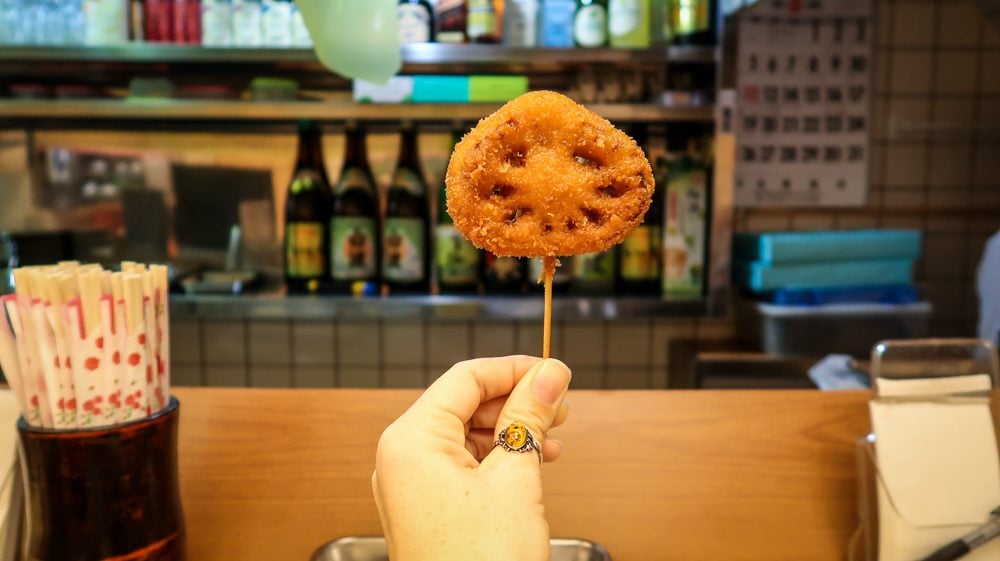
Okay, this is not a dish exactly, and it’s not exclusive to Japan, but we think it should be on your list of things to try during your trip nonetheless.
We became obsessed with lotus root while living in South Korea, and think that it’s totally underrated. It’s difficult to find outside of South Asia, so be sure to give it a taste when you’re in Japan.
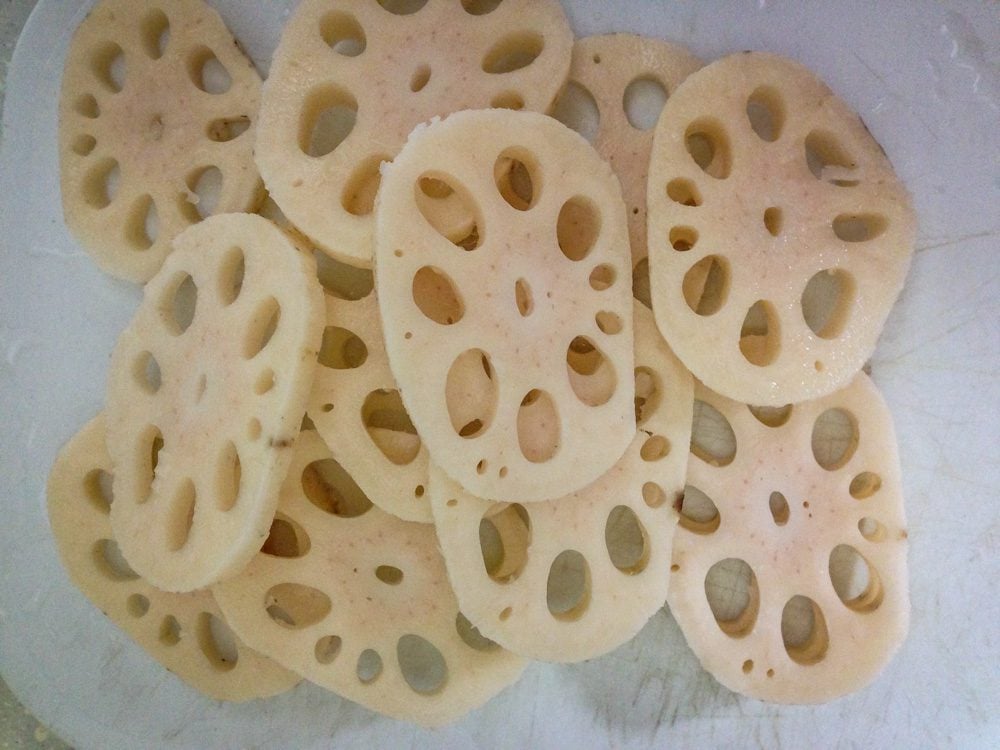
This root vegetable is typically sliced into thick disks, and can be recognized by the holes that form a lacy pattern. It remains crunchy — like a raw potato — even after cooking, and has a subtly sweet flavor, reminiscent of jicama.
How to eat lotus root: Lotus root is versatile and served in a variety of ways: from deep fried on kushikatsu skewers (pictured above) to stir fried for a side dish in a bento box to light and crispy tempura, they’re all delish!
Noodles
I consider myself a bit of a noodle soup connoisseur (anyone else?!), so I was excited to eat ALL the noodles in Japan!
14. Ramen
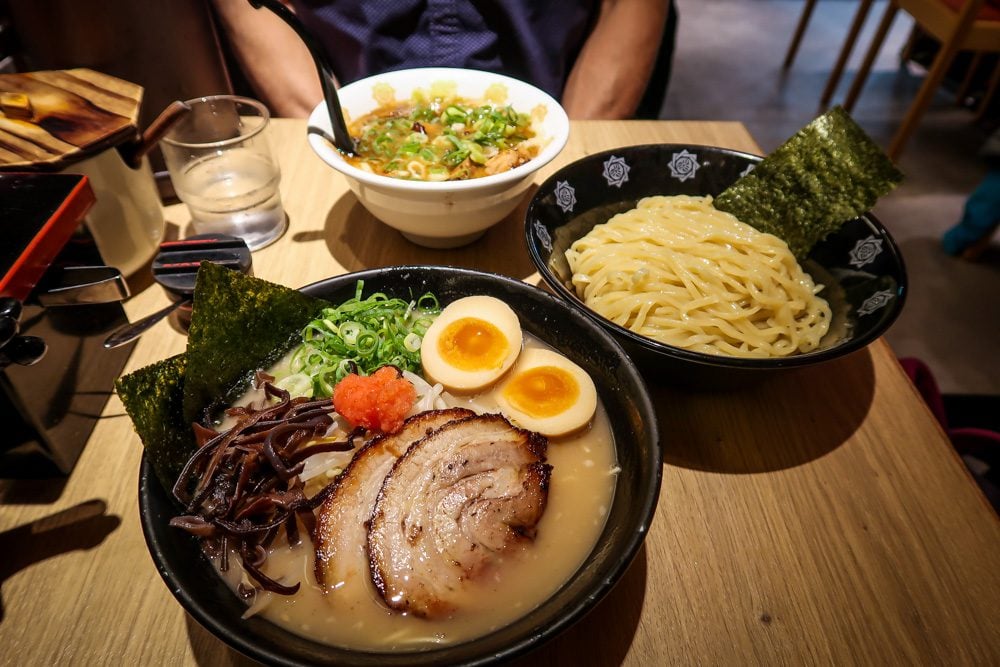
Those sodium-laden packages of dried noodles you lived off of during your college years are an embarrassment compared to the rich, satisfying and gourmet ramen you’ll find in Japan…
In Japan, the noodles are freshly made and the broth has a surprising depth of flavors. Top that with thin slices of tender pork, a soft boiled egg cooked to perfection, and a generous pile of green onions for an explosion of flavors and textures.
Okay, gotta stop now. My mouth is watering.
The packaged square variety is a distant cousin to this culinary star, which is becoming popular around the world. But just like sushi, there aren’t many better places to try it than in Japan.
When ordering ramen in Japan, you might be surprised to see there are a ton of options available. Let’s go over some of the basics so you can avoid confusion.
There are 4 basic types of ramen broth
- shio= salt-based broth
- light in color and flavor
- shoyu= soy sauce-based broth
- light brown color, a bit more flavor than shio, but still clear broth
- miso= soybean paste broth
- tangy flavor and thicker, opaque broth; sometimes there are options for spicy miso
- tonkotsu= pork bone broth
- opaque in color, depth of flavors and more viscous than shio or shoyu broths
While the more traditional version of this dish comes with a thin slice of pork, a nori (seaweed) sheet, a soft boiled egg, and a pile of shredded green onion, you’ll find versions of ramen with seafood, ground pork, chicken, and a variety of vegetables. The noodles can vary as well.
If you’re traveling around Japan, you’ll find different regional spins on this dish, so order it often to find you favorite version.
How to order ramen
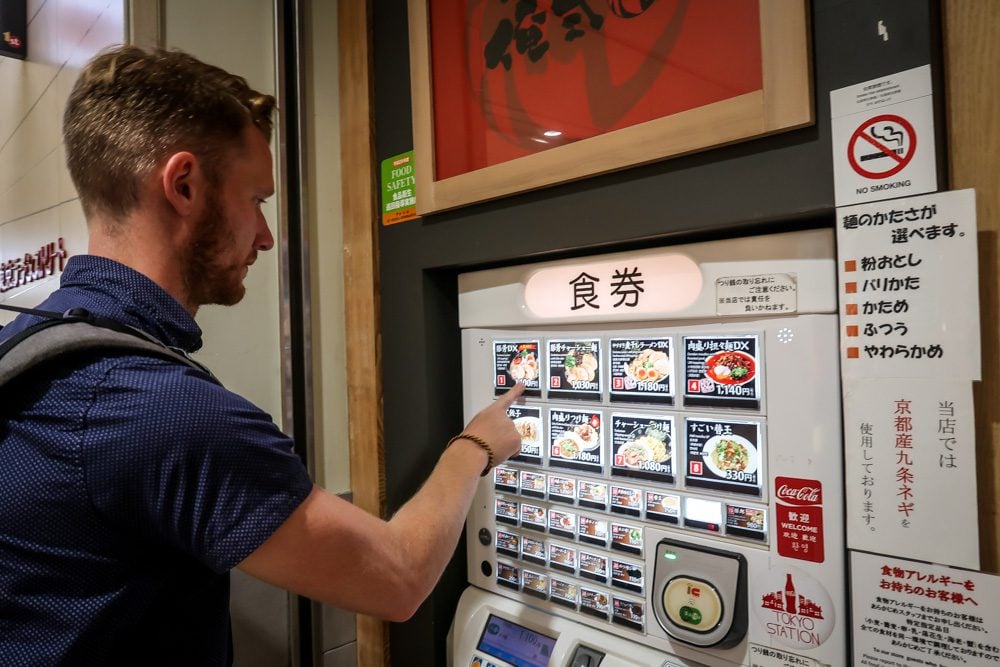
Most ramen shops have a vending machine of sorts, from which you will purchase a ticket before entering the restaurant at all. Hand the slip to one of the workers and take a seat.
Ramen is usually a fast food type of meal, and shops get absolutely packed during meal hours. This means each seat is valuable, so it is not allowed in most ramen shops for two people to split one dish. If you are traveling with a partner, both of you should order something.
Also, I speak from experience when I say you may want to tie your hair back when enjoying this meal. One ramen shop we were at even provided hair ties to customers with long locks!
Oh, and the rumors are true: slurping loudly is totally okay, and even encouraged because it helps cool down the noodles as you eat them so you can dine, dash and pass on your seat to the next patron.
Do you really love ramen? Why not make your own in a ramen noodle cooking class! We made our own noodles from scratch, and made three different versions, each with their own scratch-made broth. Bonus: This cooking class can be altered for vegetarians!
Where to eat ramen in Japan
You will have no problem finding ramen shops all around the country. Sometimes the hole-in-the-wall shops are just as good (if not better!) than the super famous ones. And this dish is a great budget option: starting at 500 yen, the fanciest version of this dish shouldn’t be much more than 1,200 yen.
- Ichiran: Speaking of famous, the most iconic ramen chain in the world is Ichiran, and they have locations in most major cities in Japan. Eating in Ichiran famous “ramen cubicles” is an experience in itself!
- Ramen Street: Another well-known place to get ramen might sound kind of strange… Underneath Tokyo Station lies “Ramen Street”, which is a clustering of 8 ramen shops that have been deemed “the best in Japan”. Here is a guide to the shops in Ramen Street.
- The most famous shop is unarguably Rokurinsha, which is known for a style of ramen called tsukemen, where noodles and broth are served separately and you dip each bite. Its popularity means there will likely be long lines, so if you don’t have the time to wait, nearby Oreshiki Jun is known for tonkotsu-style ramen, but has tsukemen that we thought was incredible!
→ Are you going to be in Tokyo? Check out our Tokyo Ramen Guide for all of our favorite ramen spots around the city, plus tips on what to order!
15. Udon
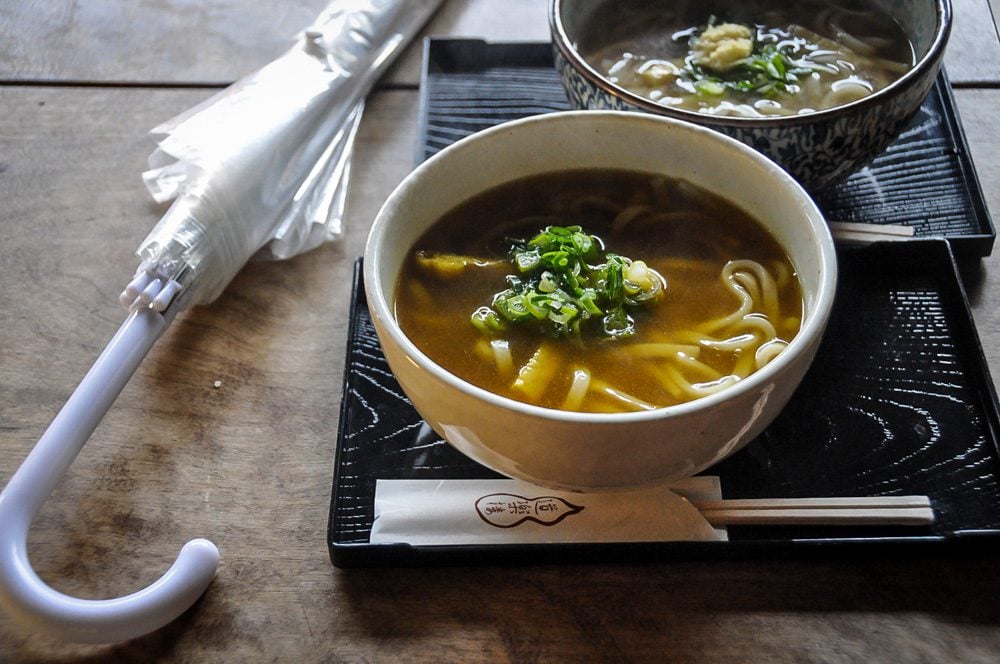
This hot soup comes brimming with thick, chewy noodles in a steaming, delicate broth and thinly sliced scallions. It is both simple and satisfying. Additional toppings, like tempura prawn or deep-fried tofu can be added.
The best part? The price tag is usually under $5 USD, making it a great lunch option for budget travelers.
Good to know: While it might seem like this would be a good vegetarian option, it’s good to note that the traditional broth is made with dashi (stock made with dried fish).
Where to eat udon: You’ll find this noodle soup all over the country, but if you’re in Tokyo and have some time to spare waiting in line, head to Shin Udon which is supposed to be incredible. We got there close to closing time and they weren’t allowing anyone else to join the line. Bummer dude!
16. Soba
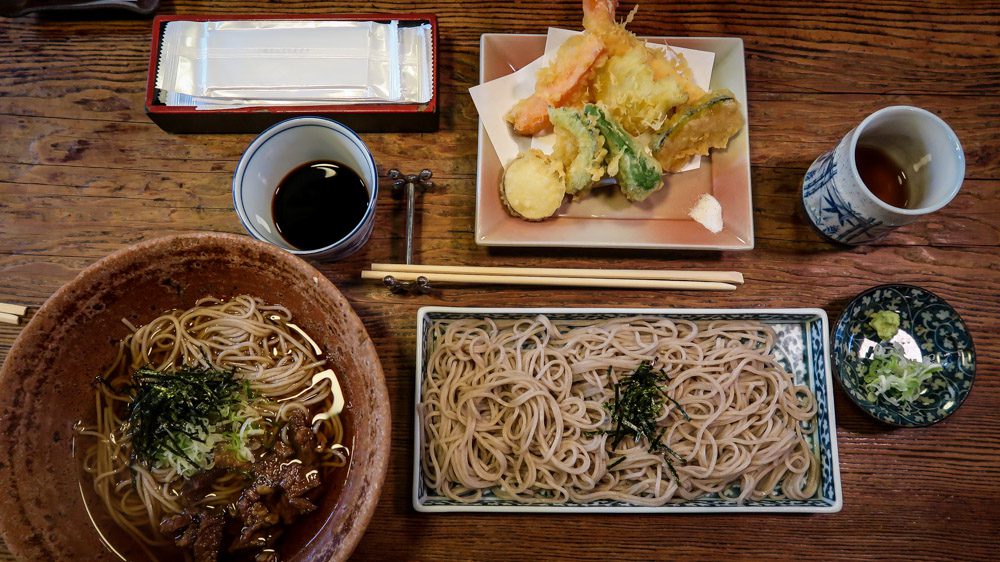
This type of noodle is made from buckwheat, giving is a slightly chewier texture and a heartier flavor than ramen or udon.
Soba is served hot or cold, the latter of which is not served with a broth like you might expect. Instead, noodles are served cold alongside fresh wasabi and a tangy dipping sauce which you can dunk each chopstick-full bite into before enjoying.
It is the perfect option if you’re craving noodles on a hot day, and is often served with tempura vegetables and prawn. (See both versions pictured above.)
Important note: Even though buckwheat is naturally gluten-free, soba noodles in Japan are typically mixed with wheat flour. This means that unless it is specifically noted, soba noodles are not a good option for gluten-free travelers.
17. Yakisoba
Translating to “fried buckwheat”, this stir fried mixture of noodles, veggies, and a sweet and savory sauce is an easy dish for non-adventurous eaters.
For a fun meal, pick a restaurant where you can belly-up to your very own hotplate. Choose your meat and veggies and cook it yourself before indulging in fried noodle yumminess.
Even though “soba” is in the name of this dish, it’s worth noting that the noodles are actually made with wheat flour and are more similar to those you’d find in ramen rather than buckwheat noodles.
Weird but true: Another way you’ll see yakisoba is stuffed inside a hot dog bun, and on the convenience store shelves. I’m going to be honest, the combination of noodles inside of bread kind of grosses me out… but if it intrigues you, by all means, indulge in that carb-on-carb action!
Japanese meals
We’re going beyond specific Japanese dishes, and we’re adding some types of meals that are common in Japan and should be added to your “must-try” list!
18. Kaiseki
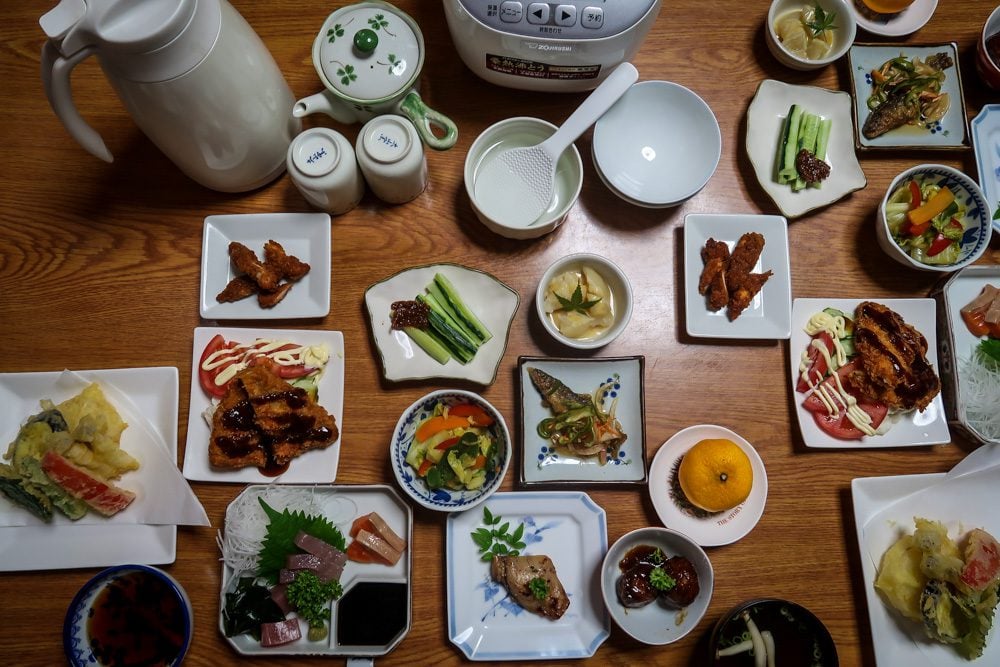
The word kaiseki doesn’t refer to a specific dish, but instead to a type of meal. Or rather, a feast!
In the most basic form, kaiseki is a meal that consists of many (many!) small plates. But if you dive a little deeper, you’ll find that kaiseki is more than just many dishes — it about the experience, the presentation, the details, and the hospitality that goes into meticulously preparing this type of meal.
Kaiseki is typically very expensive, and once you experience it for yourself, you’ll understand why: there is just so much that goes into this type of meal.
Each kaiseki is different, and often times will reflect ingredients that are local or in season.
For example, while hiking the Kumano Kodo Trail, we stayed in a small village near a river. Our kaiseki dinner and breakfast included lots of grilled fish — both from the river and the coast which wasn’t far.
However, when we did a Koyasan temple stay, our kaiseki dinner and breakfast were vegetarian, following Buddhist customs.
Where to eat kaiseki: Often times high end ryokan (traditional Japanese inns) will include a kaiseki dinner and breakfast for their guests. (And by “include” I mean you will pay for it in the price of your room!) You can also seek out specialty kaiseki restaurants.
19. Bento Box meal
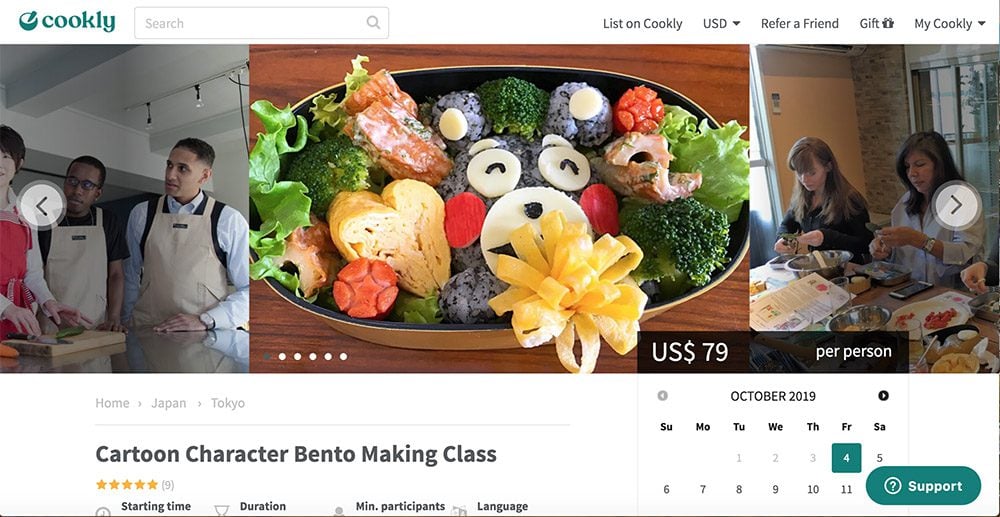
This is pretty much just a fancy way of saying “boxed lunch”. A variety of dishes — including rice or noodles, meat or fish, and some sort of vegetable — comes packaged nicely in a box with different compartments. Think of it as a much (much!) nicer TV dinner.
You can find bento boxes at convenience stores and train stations throughout the county. This is also what homemakers prepare for their children to take to school (or spouses to take to work), and lots of effort is put into making them look nice.
Today, there is a trend in bento boxes to make them look pretty — oekakiben or “picture bento”. The food is arranged to look like a character or scene.
Learn how to make your own super cute bento box in a cooking class! More traditional and vegan options available too. Check availability here.
20. Shabu-shabu
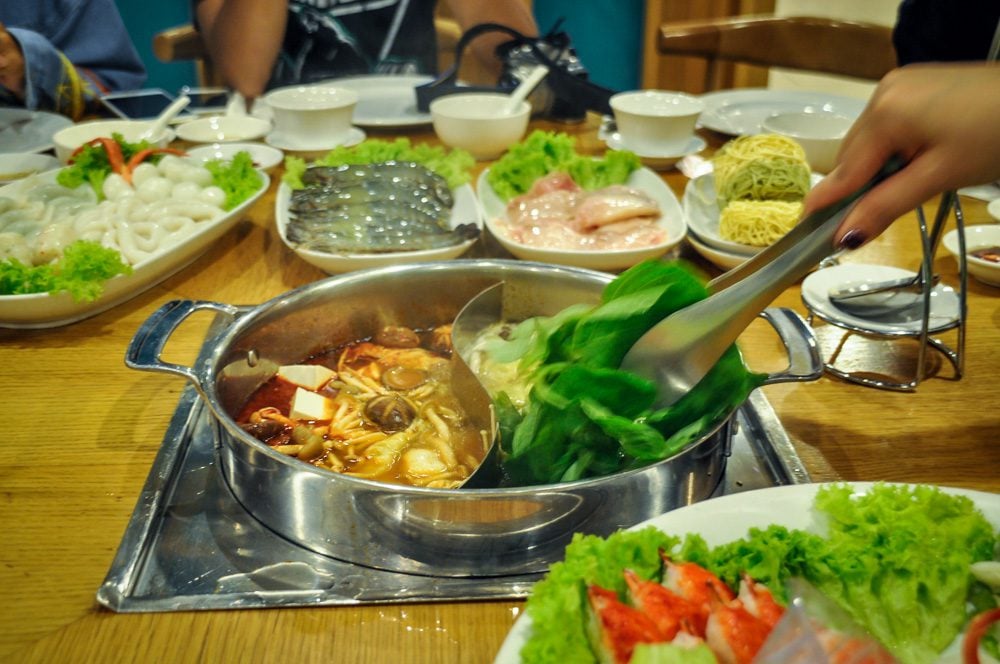
Supposedly, this Japanese hotpot dish gets its name from the sound that meat and vegetables make while cooking in hot broth. However its name was derived, we can agree that shabu-sabu is yummy-yummy (couldn’t resist!).
When you waltz into a shabu-shabu restaurant, you’ll be seated at a table with a large pot which you can control. You may be able to choose a type of broth, and you’ll be presented with a variety of ingredients you can add to said boiling broth.
Tip: When cooking thinly-sliced meat, only dip it in the broth for a few seconds to avoid over cooking it.
Unlike what you might assume, this meal is not exactly a soup. Instead, the broth is a way to cook ingredients before dipping them in sauces, like ponzu or sesame. When you’re finished cooking the meats and veggies, the leftover broth can be eaten (often with steamed rice).
Typically, you’ll shabu-shabu restaurants give customers a time limit, such as 90 minutes, to ensure you don’t just camp out all day. Before your time runs out, be sure to grab some ice cream, which is a added bonus at many shabu-shabu restaurants!
Where to eat shabu-shabu: You’ll find shabu-shabu restaurants throughout Japan (some offering vegetarian options) and around the world. We actually tried our first shabu-shabu in Bangkok!
21. Yakiniku
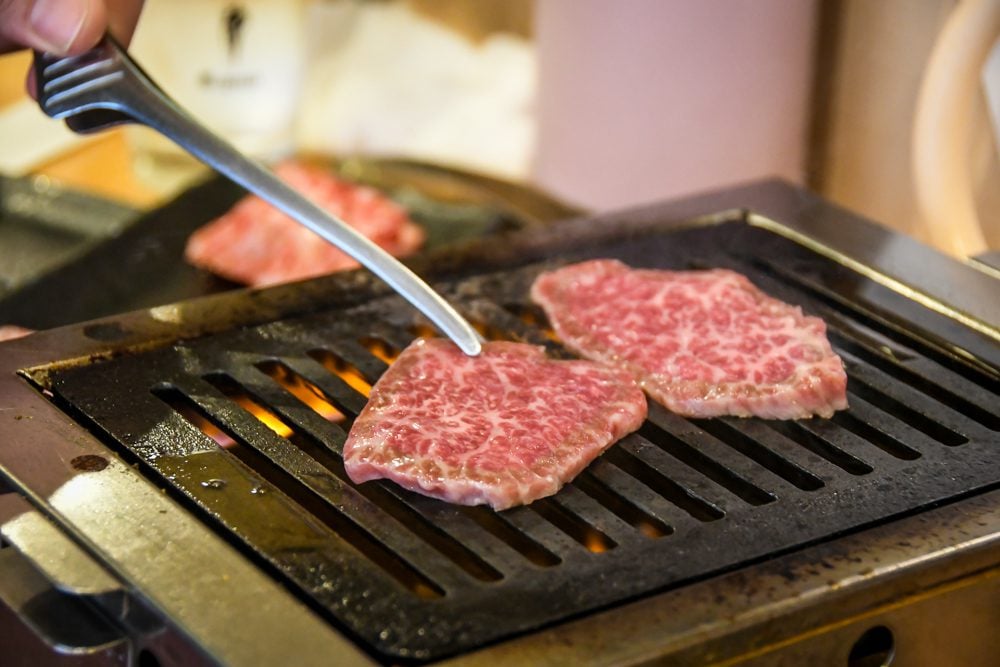
Yakiniku refers to barbecue, or grilled meat.
Korean barbecue is gaining popularity in the West, and not surprisingly, was the inspiration for the Japanese take on this type of cooking.
At yakiniku restaurants, you’ll be served raw slices of meat and vegetables to cook on your own personal grill. After grilling, dip in flavor-packed sauces and enjoy the complimentary side dishes for a super tasty meal.
Note: Yakiniku can be a good option for gluten-free travelers if you skip the dipping sauce and instead season the meatwith shio, or salt. can be a good option for gluten-free travelers if you skip the dipping sauce and instead season the meatwith shio, or salt.
22. Kombini Meal
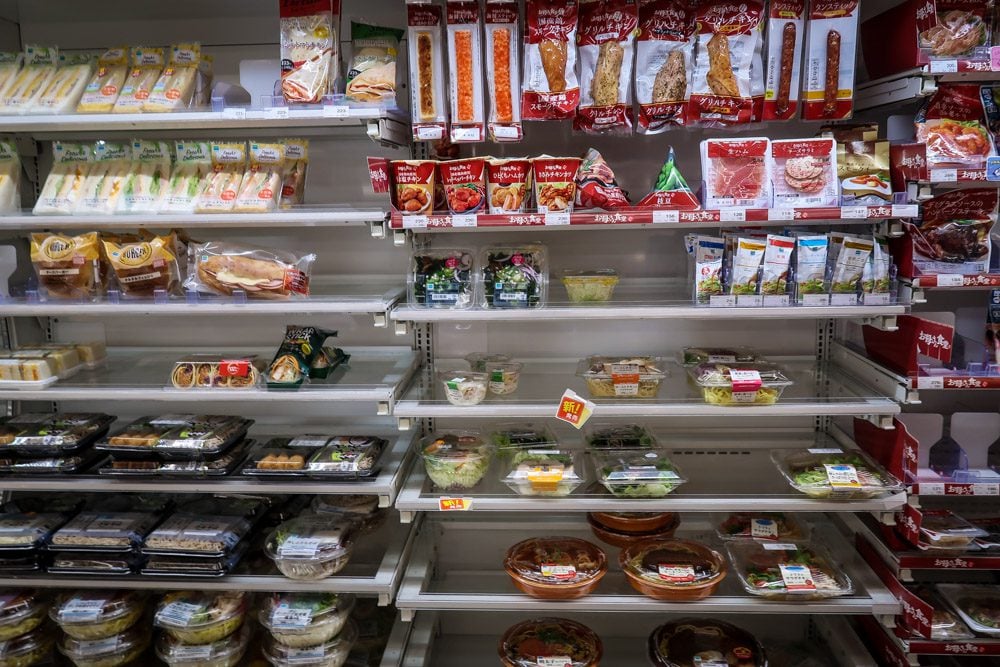
Kombini means “convenience store”, and yep, we’re going there…
If you’ve done any bit of research on Japan, you likely know that convenience stores in this country are on an entirely different level than the rest of the world. In addition to the snack foods you’d find at any convenience store, you’ll also find tons of ready-made meal options, making “kombini meals” a staple of travelers on a tight budget.
I’ve read some articles which make it seem like you’ll be eating like royalty at Japanese convenience stores.
I’m just gonna take a second to pop in and say, yes, convenience store food in Japan is better than what you’d expect from any other country. But it’s still just that — convenience store food: processed and made to be quick and cheap.
Definitely plan on getting a few meals from 7-Eleven, Family Mart, or Lawsons (the 3 most popular chains). It’s one of those “Japanese experiences” you should have. But plan to balance it out with meals from real restaurants too.
Some of our kombini favorites:
- Onigiri: cheap snack or meal on the go with lots of filling options.
- Gyoza: from the refrigerated section, staff will heat them up.
- Fresh ramen: from the refrigerated section, staff will heat it up.
- Edamame: simple and one of the healthier options.
- “Sugar Butter Sand Tree” cookies: strange name, but super yummy treat that tastes oddly reminiscent of a childhood cereal I just can’t pin down…
- Old-fashioned doughnut: the ones from Family Mart that are half dipped in chocolate are our favorites!
- Cheesecake pudding: from 7-Eleven in the refrigerated section, this stuff is dangerously good!
Snack foods & bar foods
Between convenience stores and izakayas (small, casual Japanese pubs), this country has an overwhelming amount of snack foods that should be on your radar!
23. Karaage
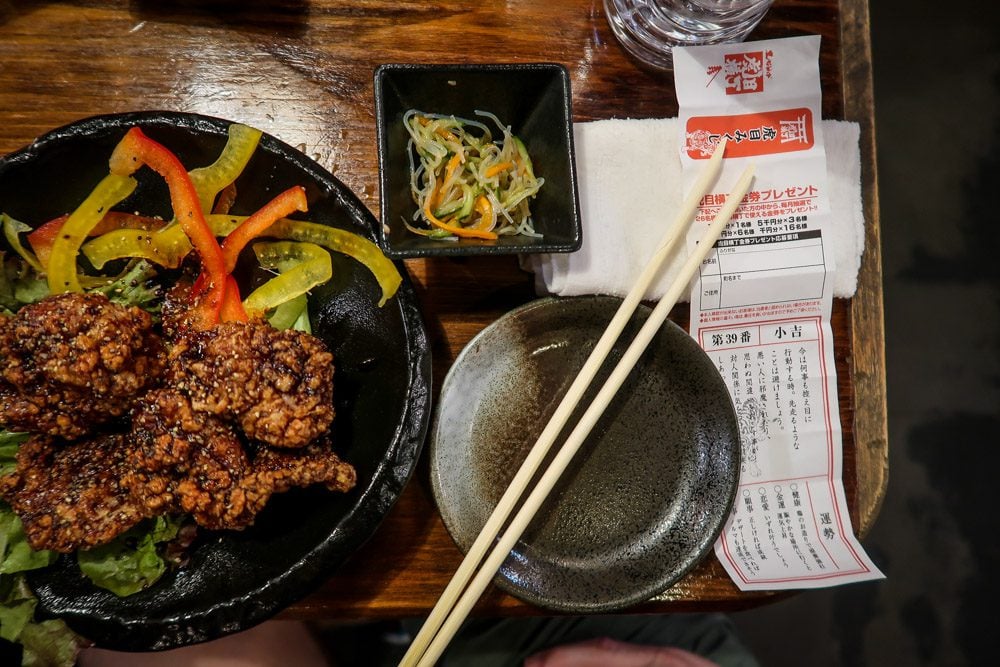
Karaage, aka Japanese fried chicken, is a perfect snack to pair with a beer at an izakaya.
This dish, along with many other breaded and fried foods, was invented as a response to the food shortages across Japan after World War II. There was an excess of wheat flour, and this was an easy way to cook chicken and give it a bit more bulk.
Good to know: Karaage usually refers to fried chicken, but can also be deep fried fish, so if you prefer seafood, you might want to give that version a try!
The Japanese version of fried chicken is extra crispy on the outside and very flavorful. The chicken is typically marinaded in a blend of soy sauce, ginger and garlic before being breaded, deep fried, and served with a lemon wedge for a bit of a fresh zing.
Where to eat karaage: Izakayas (Japanese bars) are popular places to try this snack, and you can even find it at convenience stores, like 7-Eleven and Lawsons.
24. Yakitori
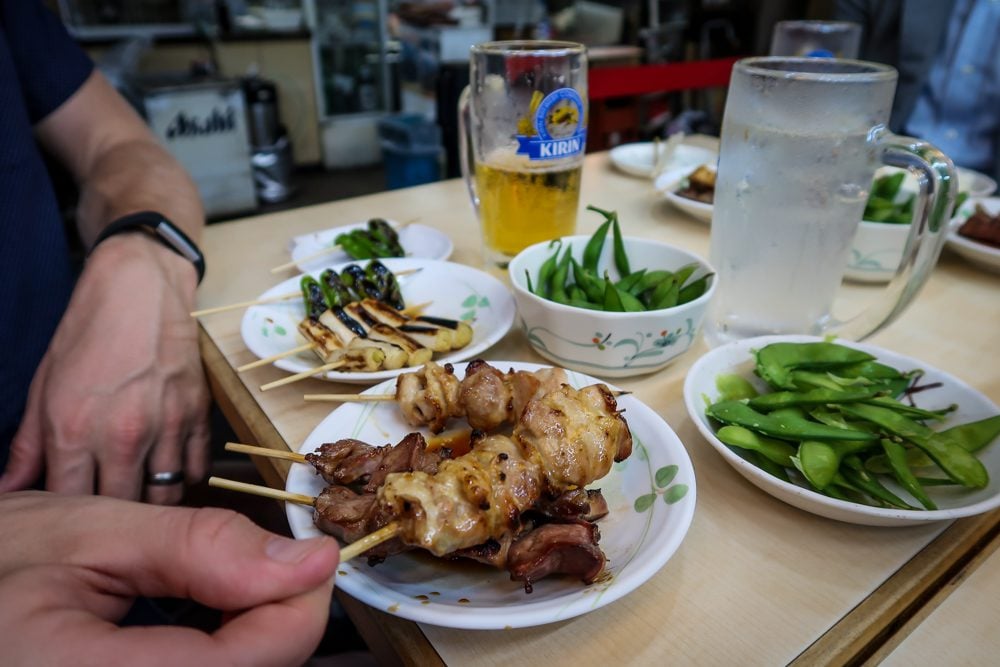
Using our Japanese cuisine glossary at the bottom of this article, it’s easy to figure out that yakitori means “grilled chicken” (yaki= grilled, tori= chicken).
More specifically, yakitori are skewers with pieces of chicken grilled over a charcoal fire. It’s a very popular snack to eat while drinking beer, and you can find it at izakayas throughout the country. Just look for a smoky grill and you’ve most likely found what you’re looking for!
Yakitori can include all parts of the chicken: breast, thigh, skin, liver, heart and cartilage.
Typically, one type of meat is served together on a single skewer, so stick to the breast or thigh if you’re not feeling too adventurous. Or be bold and try something different. Or perhaps you’ll accidentally order heart, like we did!
Most izakayas that specialize in yakitori have other options as well, like green onion, shiitake mushrooms, shishito peppers, and tiny enoki mushrooms wrapped in bacon. Edamame is also a staple that you should be able to find at these places as well.
Some great things about yakitori
- it’s cheap, usually between 100-200 yen per skewer
- the atmosphere is great, as it’s a popular snack post work hours for Japanese businessmen
- good vegetarian option (obviously you’d need to order the veg skewers instead of meat, duh!)
- it can be a decent gluten-free option too, as long as you specify that you want it cooked with shio (salt), not tare (traditional sweet and savory yakitori sauce)
- Read more about traveling in Japan with dietary restrictions below.
Where to eat yakitori: This is a popular dish at izakayas, especially those near business districts where salarymen congregate after work hours. If you’re in Tokyo, a good place to try this snack is in Omoide Yokocho, or “Piss Alley”, which is just outside the west gate of Shinjuku Station and one of the best places to explore Tokyo at night.
Our recommendation: For a really cool local vibe, find a seat at Yakitori Ton Ton, which is underneath a railroad track and has smokey, noisy, authentic vibes. If possible, go on a weekday so you observe salarymen getting drunk after a long day at the office. We sat across from two Japanese businessmen who we are pretty sure were closing a business deal over beer and yakitori.
25. Kushikatsu
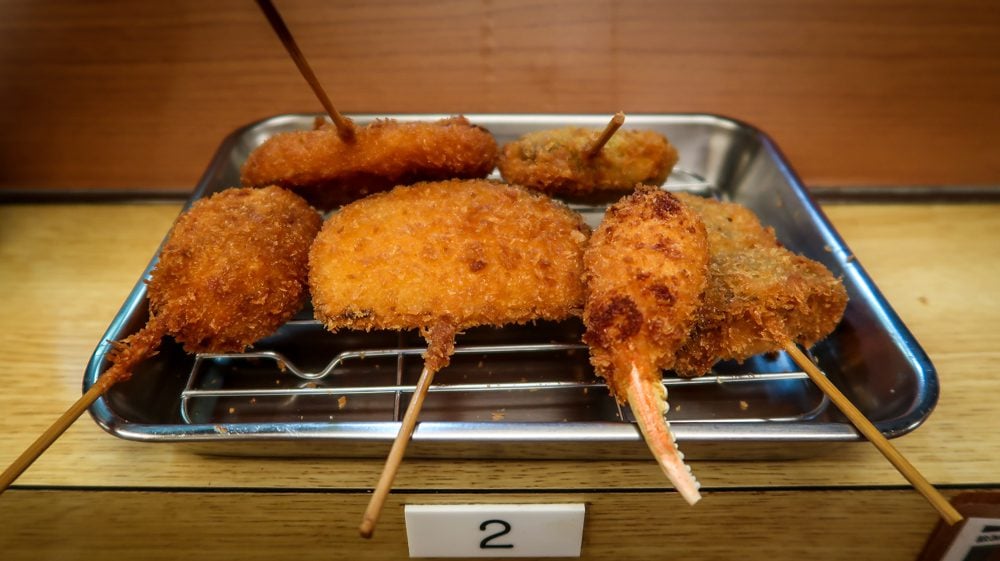
Kushi, means “skewers”, and katsu, means “fried”. When you put them both together you’ve got a tasty snack of skewered meat and vegetables that have been breaded and deep fried.
Instead of the light, crispy texture you’d find in tempura, kushikatsu uses a heavier batter, including breadcrumbs, for a hearty crust.
It comes served with special kushikatsu sauce that has a Worcestershire base, and each restaurant makes their own version. Often times locals frequent the restaurant that has the best dipping sauce, because that’s where you really get the flavor!
One important piece of etiquette you need to know is that it is NOT okay to double dip at kushikatsu restaurants.
Typically, the (super yummy!) sauce is served in a large container and is used throughout the day. There are often times signs that warn patrons against double-dipping, but they may be in Japanese.
Fun fact: It’s easy to find kushikatsu restaurants once you know the kanji (Japanese character) for kushi: 串 This symbol is used because it looks like pieces of meat on a skewer, and is usually printed large on signs of kushikatsu restaurants.
Where to eat kushikatsu: You can find this dish many places around the country, but it originated in Osaka, specifically the Shinsekai neighborhood. Here you will find tons of kushikatsu joints to choose from.
26. Takoyaki
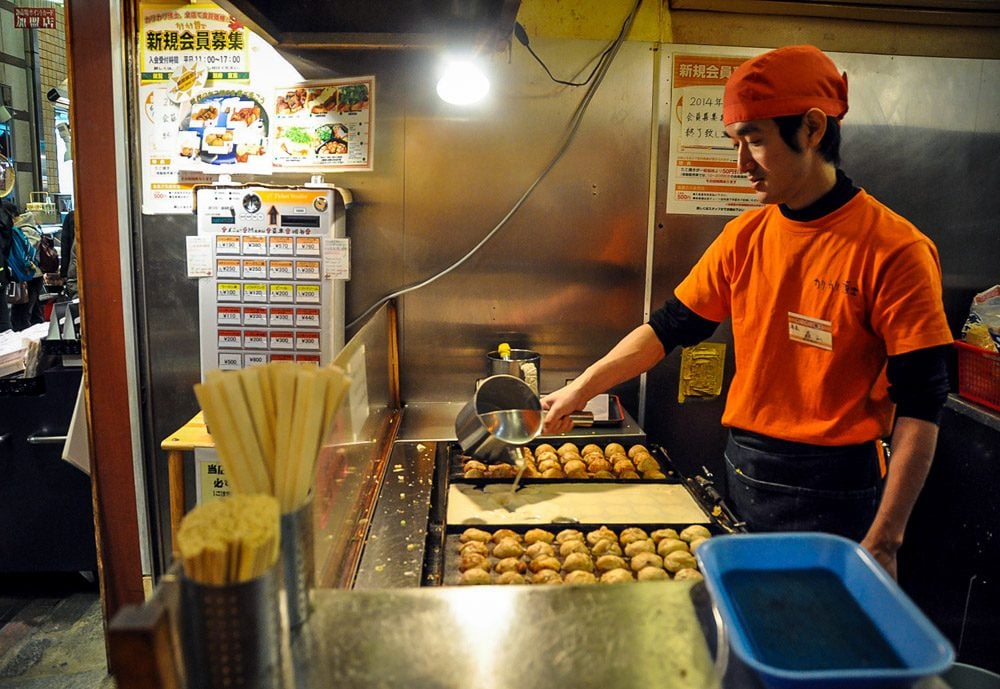
Sometimes referred to as “octopus balls”, this popular Japanese snack is a lot more delicious than the name implies.
These balls made of batter are stuffed with chopped octopus, then topped with flavorful sauces, pickled ginger, tempura crumbs, bonito flakes, and nori pieces.
You’ll find these crowded stands in markets by day, and on busy streets at night.
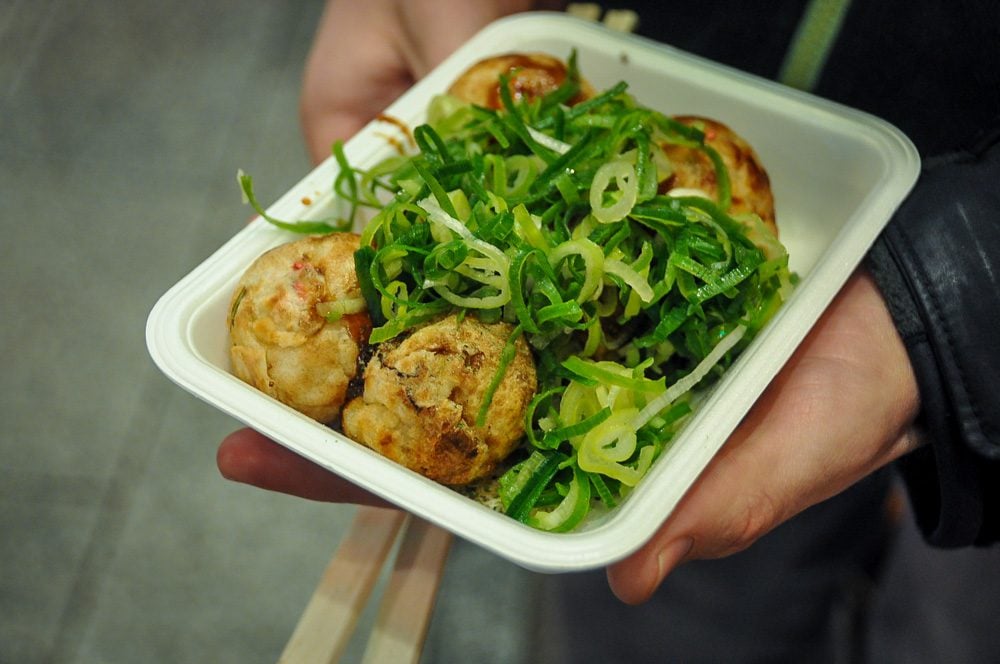
We like takoyaki, but they aren’t for everybody. They’re typically pretty cheap, so give them a try and see what you think!
It’s quite common for Japanese people to have their own takoyaki mold pan at home that they’ll use to make their own versions of this dish. We spoke with one local who has tried all different combinations — even cheese and tomato to replicate pizza. Yum!
27. Gyoza
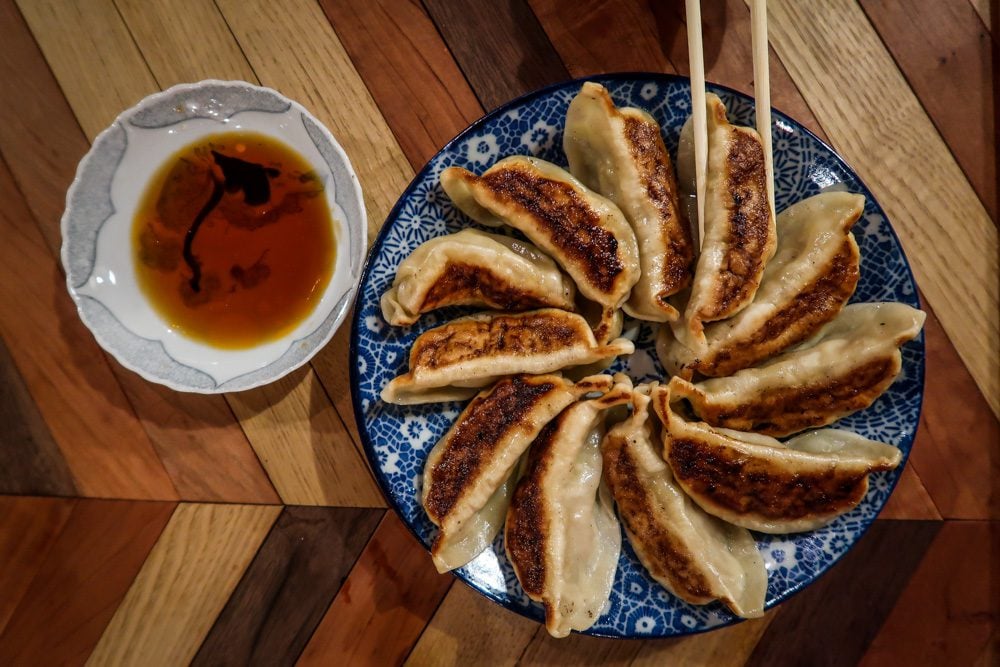
These tasty little pocket-filled bites of of minced pork, cabbage, chives, garlic, and ginger, are dipped in a blend of soy sauce, rice vinegar and chili oil for a lip-smackingly good snack (or full meal if you can eat as many as we can!).
You can order them pan-fried where the skin gets a little crispy (our favorite!), or steamed for a softer bite.
Like many other dishes that Japan is known for *cough… sushi and ramen, cough, cough* gyoza is the Japanese take on a dish from overseas.
During World War II, Japanese soldiers got a taste of these dumplings in northern China, and they were so delicious they wanted to replicate them when they got home. Apparently, gyoza is the pronunciation of their original Chinese name, jiaozi, which you might know as “potstickers”.
The main difference between the Chinese and Japanese version of these dumplings is that in Japan the skins are typically thinner and there is a stronger garlic flavor, whereas the Chinese version uses handmade dough which results in a little thicker, more rustic skins.
Where to eat gyoza: You’ll be able to find these babies in convenience stores in the refrigerated section. The employees can heat them up for you. They are also available at some izakayas.
28. Nikuman
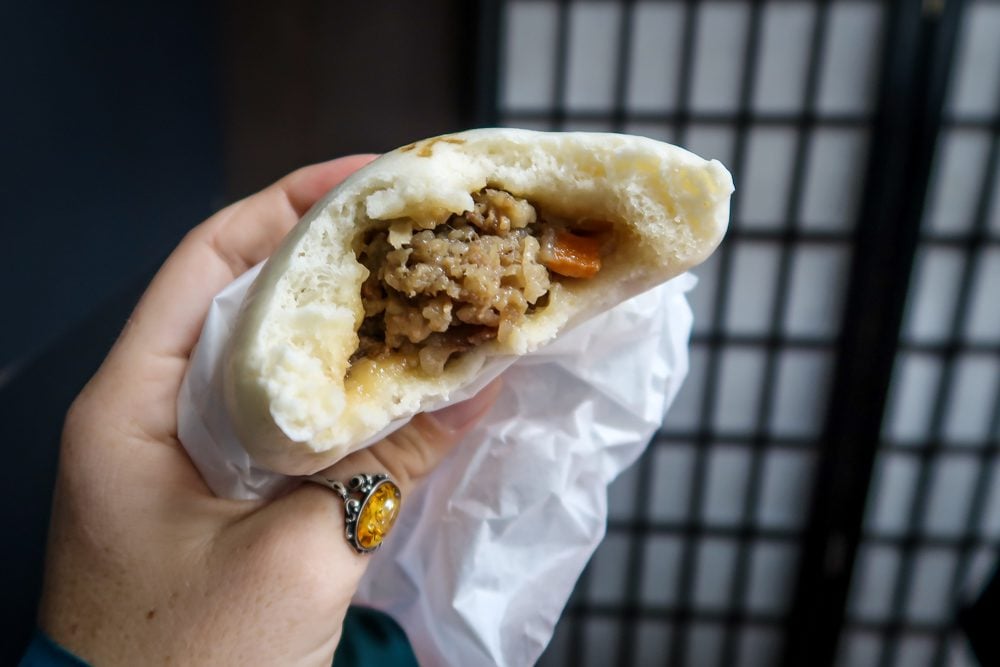
Nikuman is the Japanese word for Chinese steamed buns, or baozi, which are typically stuffed with ground pork, onions, and spices.
These steamed buns are light, fluffy and are a cheap and satisfying snack on the go. While pork is the most popular filling, you can find other varieties as well, such as shiitake mushroom, pumpkin, or beef.
Where to eat nikuman: These steamed dumplings are often sold as street food, and are especially popular during festivals and throughout the winter months. You can also find them at convenience stores throughout much of the year.
29. Senbei
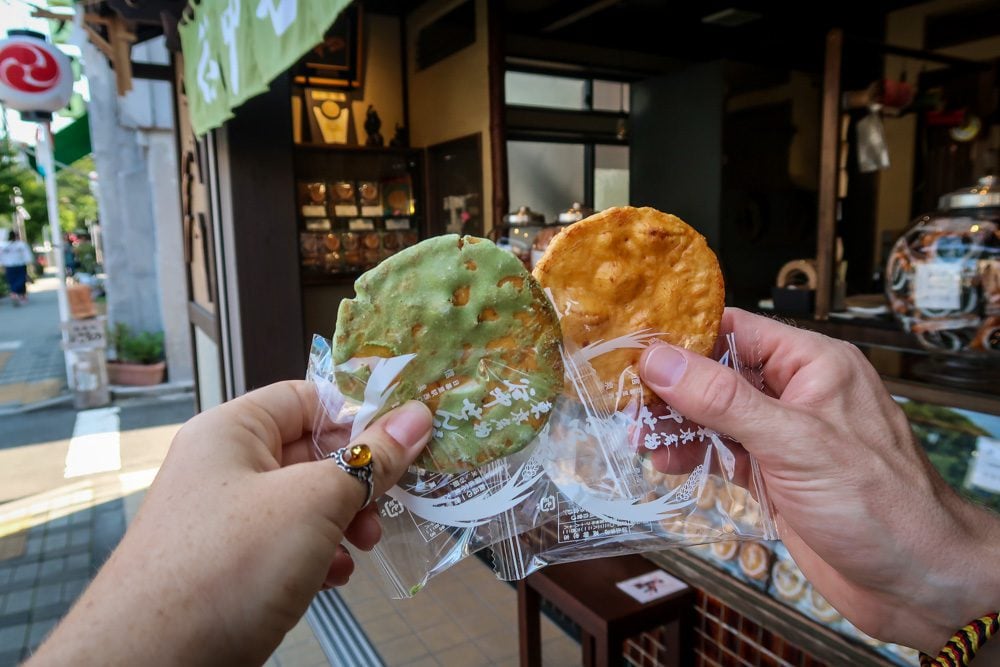
These Japanese rice crackers are a crunchy snack that can be found in both sweet and savory varieties.
Traditionally, these crackers are grilled over charcoal and brushed with a sweet soy sauce for flavoring. They are often eaten with tea, or offered to guests in ones home.
While they date back to centuries past, these crackers can be found on supermarket shelves in Western countries. And the variety of flavors has expanded to include modern tastes.
30. Korokke
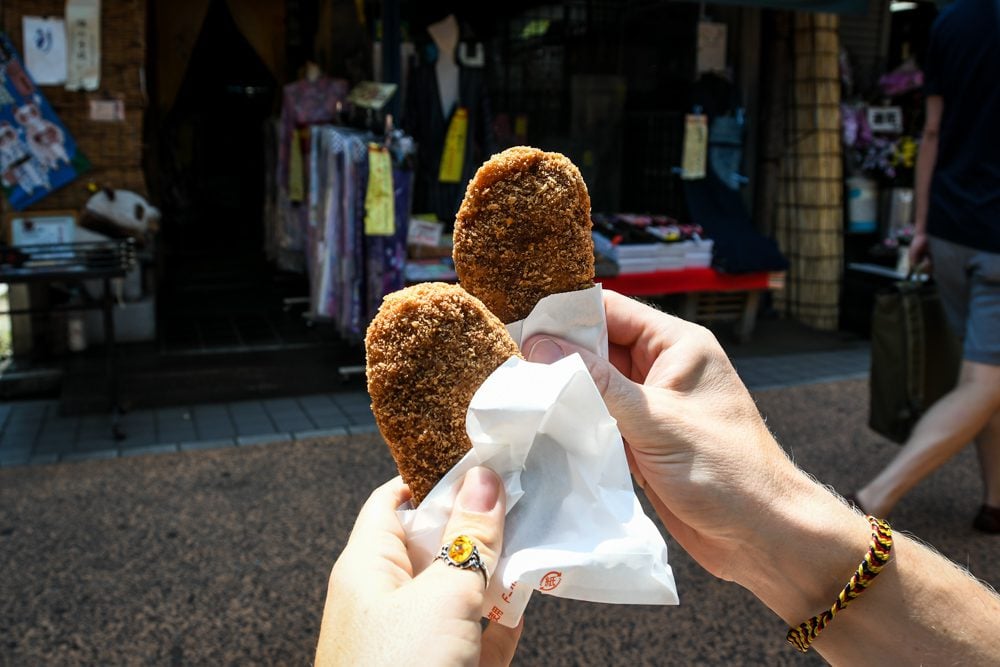
These potato croquettes are the Japanese version of France’s original.
You can find korokke in convenience stores and sold on the street, and there is a variety of flavors available: from potatoes mixed with meat, vegetables, curry, and even tuna.
They are breaded and deep-fried for a crunchy, satisfying, and portable snack.
Sweets
We’d be remiss if we forgot to mention sweets in Japan. So for all you dessert-lovers out there, this section is for you (and your sweet tooth!).
The most notable type of sweets in Japan is wagashi, which are confections served with tea. All but the last in this section are types of wagashi.
31. Mochi (daifuku)
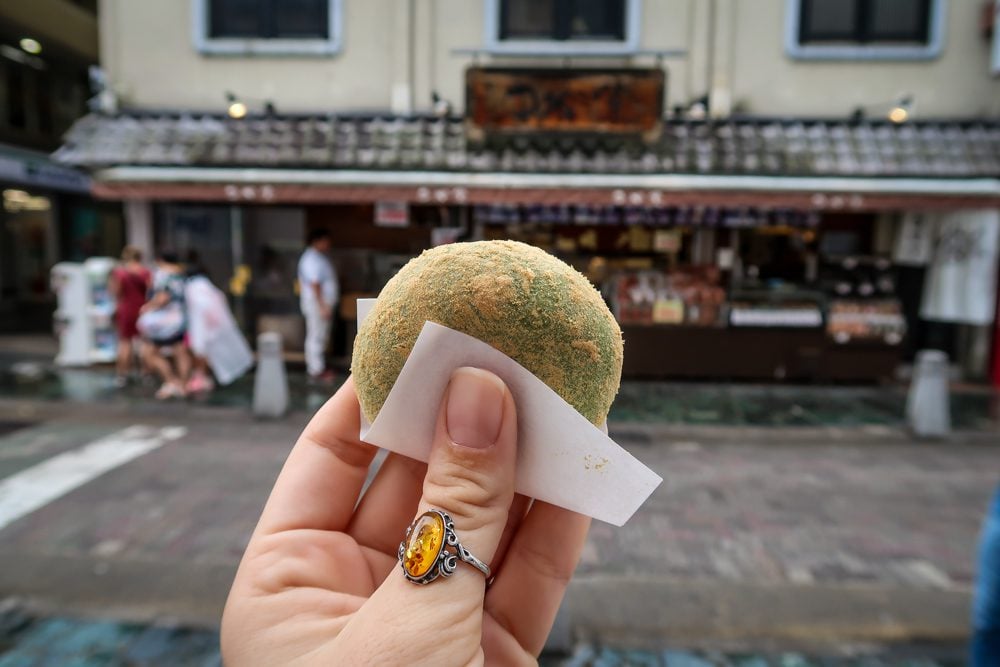
If you’re anything like me, you already know (and love!) the ice cream stuffed version of this treat that is sold in supermarkets around the world.
But in Japan, mochi simply refers to a rice cake, which can actually take on many forms.
The rice dough makes the outside of the dumpling very chewy, and often times they are filled with something. A traditional version of this dish that you’ll find more easily in Japan is not filled with fun flavors of ice cream at all, but instead with anko.
What is anko, you ask? More commonly called “red bean paste,” this thick and lightly sweet filling made from azuki beans is used in dessert dishes all around Asia.
When we first moved to South Korea, I kept getting ice creams and pastries filled with what I assumed to be chocolate, only to find it was red bean paste. It was disappointing in the moment (I mean, you can’t really compare it to chocolate!), but I came to like the stuff.
I still wouldn’t say I love it or would go out of my way to seek it out, but it’s not bad.
And if I’m honest, I prefer the fake version sold at Trader Joe’s stuffed with mango ice cream more than the fresh type sold on the street and filled with red bean paste. What can I say, I just love ice cream!
Where to eat mochi: You can find these chewy snacks at convenience stores, but if you want the real deal, get them freshly made from a street vendor. We saw them being prepared at the famous Nakatanidou in Nara and couldn’t resist trying one.
32. Dango
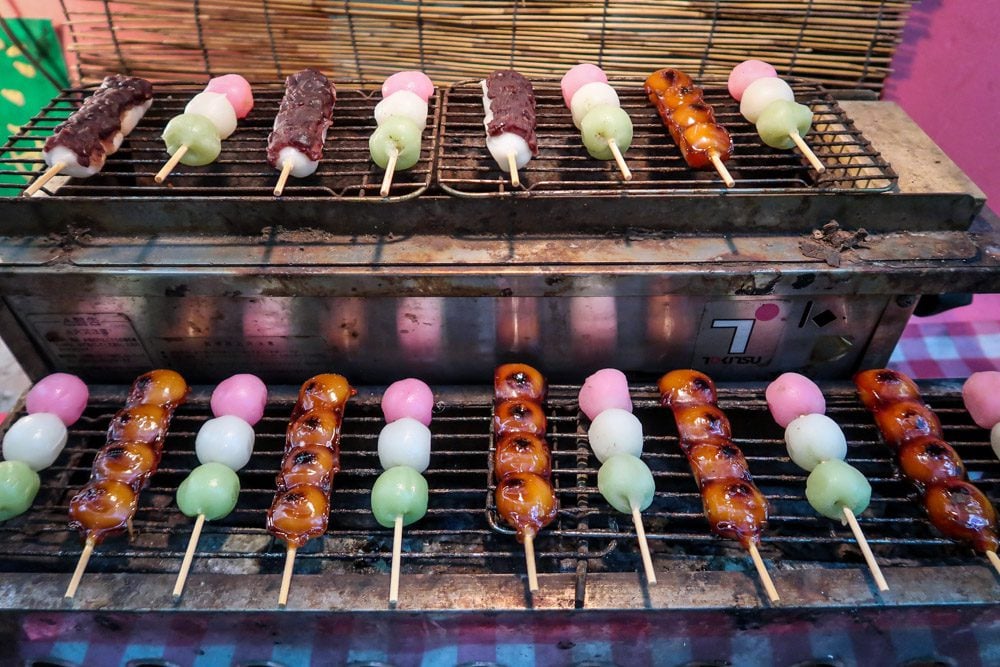
You’ve probably seen the emoji ?, but there’s a good chance you’ve never heard of dango. (We hadn’t until we touched down in Japan!)
Dango is skewered rice cake balls (similar to mochi) that are grilled over charcoal, and they come in a handful of flavors.
The most iconic is obviously the pink, white and green one that inspired the emoji, and each ball is lightly sweet. There is also a variety, mitarashi, that is brushed with a sweetened soy sauce glaze while being grilled. Another popular type of dango is topped with red bean paste, so there’s a dango for everyone!
33. Manjū
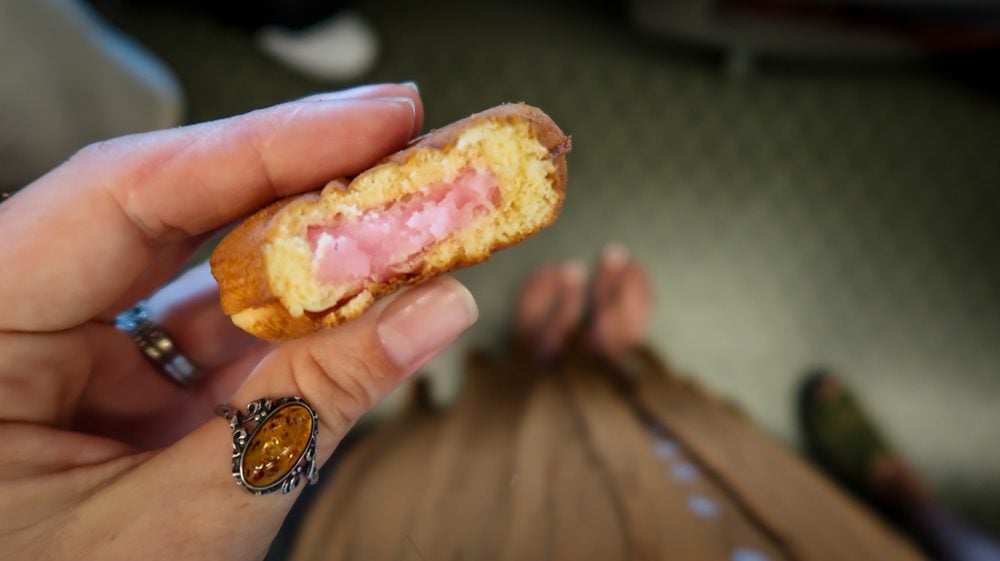
Manjū is a type of Japanese cake with some sort of filling, the most common of which is red bean paste, though fillings, flavorings, and shapes can vary.
Where to eat manju: Manjū are traditionally enjoyed with tea or eaten during special occasions, but you can also find them at traditional sweet shops.
Certain regions in Japan even have their own version of this sweet cake. An example is the maple leaf shaped momiji manjū which can be found in in Hiroshima and Miyajima.
34. Matcha ice cream
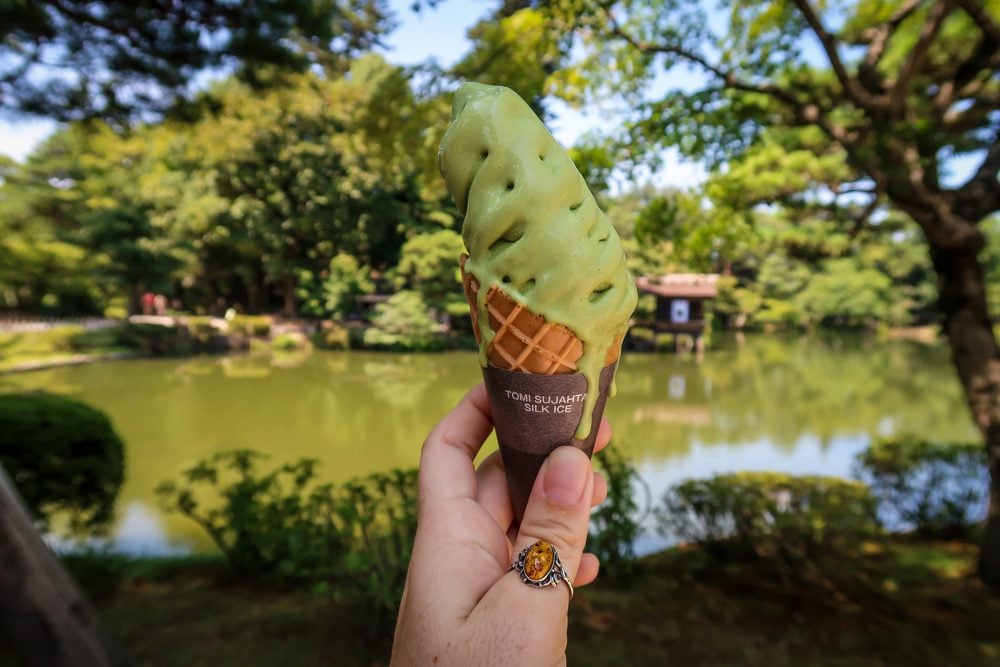
In Japan, green tea is not just a beverage. There is green tea flavored EVERYTHING: Lip gloss, KitKat bars, and yes, ice cream.
You’ll find a bevy of soft serve shops all dolling out the same specialty — matcha. If you’ve never tried it before, beware that it can be quite bitter (depending on the shop). Try it paired with vanilla for a sweeter experience.
Trendy Japanese foods
Japan is home to all sorts of trendy foods that are popular amongst younger generations and international travelers.
We’re going to go over a few of the foodie trends and share our opinions on which are actually worth the hype and which are just pretty for the ‘Gram.
35. Melon pan
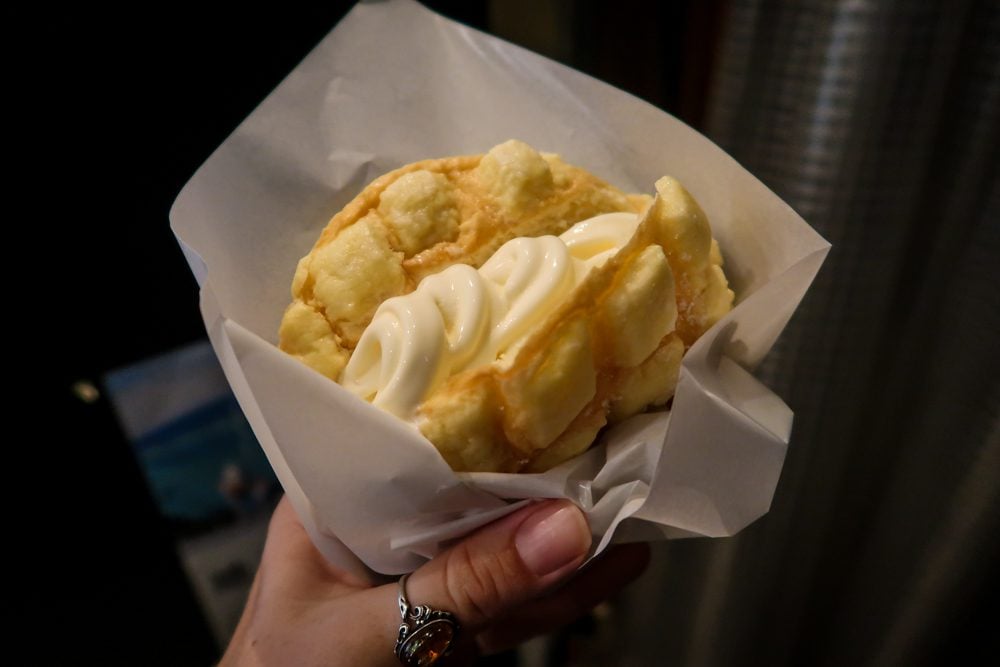
First off, let’s dispel any confusion: This sweet pastry treat has nothing to do with melons, other than the fact that the crisscross pattern on top supposedly looks like one…?
Instead of a fruity melon flavor, expect a lightly sweet, sugar cookie taste. It’s almost as if you took a sweet white bun (a la King Hawaiian rolls!) and put sugar cookie dough on top (which you carved a nice little tic-tac-toe design into). Then you sprinkle sugar on top and bake it. And now you have “melon pan”.
You can pick these up for around 100 yen ($1 USD) at most convenience stores. Or for a fresher version, head to a bakery that specializes in these treats. And for the ultimate indulgence, get it stuffed with ice cream!
Worth the hype? In our opinion, yes! We (obviously) liked the fresh ice cream sandwich version over the convenience store kind. But both were good. Plus, they’re cheap and easy to find around the country.
36. Black sesame ice cream
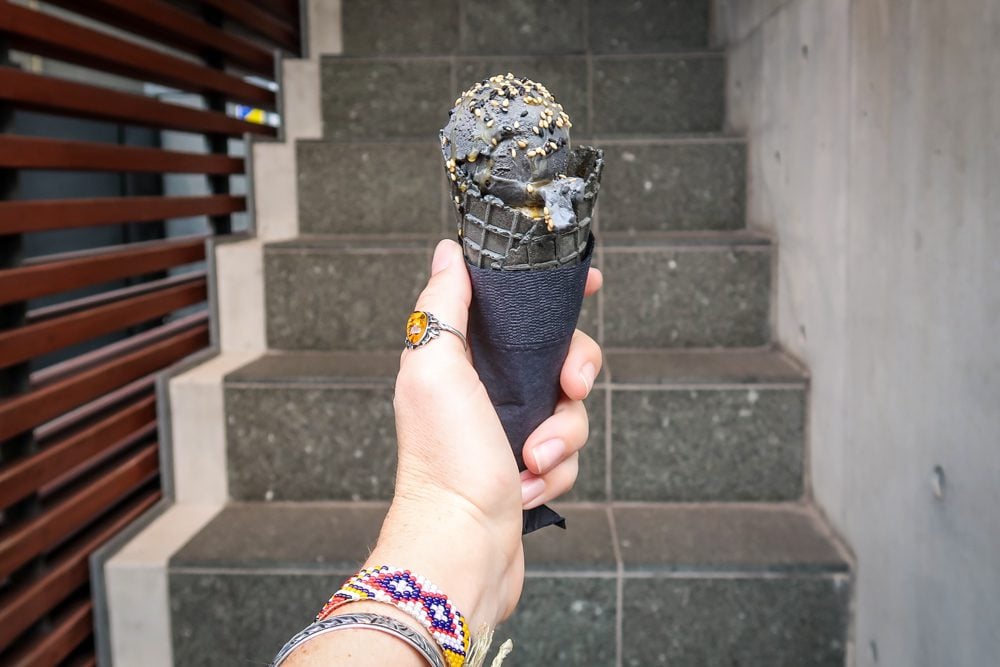
We hadn’t heard about this flavor and passed up a couple of shops that showcased black cones because we assumed they were charcoal flavor (which is a trend that I personally think is overrated).
But then someone messaged us on Instagram and told us we NEEDED to try the black sesame ice cream during our trip. I looked and looked, but couldn’t seem to find this flavor anywhere, until Harijuku (a lively neighborhood in Tokyo).
We split a cone with one scoop of white sesame and one with black sesame (gotta try ‘em both, right?!), which came to a total of 500 yen (around $5 USD).
We then topped it with a little sesame oil and a sprinkling of sesame seeds from their self-service station. And then, bless Ben’s heart, we had to wait to try it until we had taken a few photos to share with you (you’re welcome!).
Finally, it was time to give it a taste… OH MY GOODNESS, was it divine! Creamy, rich, nutty, slightly sweet, a little bitter. Sort of like peanut butter ice cream, but not quite so sweet.
I was semi-devastated that we only got around to trying this stuff on one of our last days in Japan… *insert crying emoji*
Worth the hype? Hell YES! I’m currently dreaming about making my own version of this stuff because I can’t seem to find it anywhere outside Japan. If you have the chance to try it, please enjoy it a little extra for me!
37. Soufflé pancakes
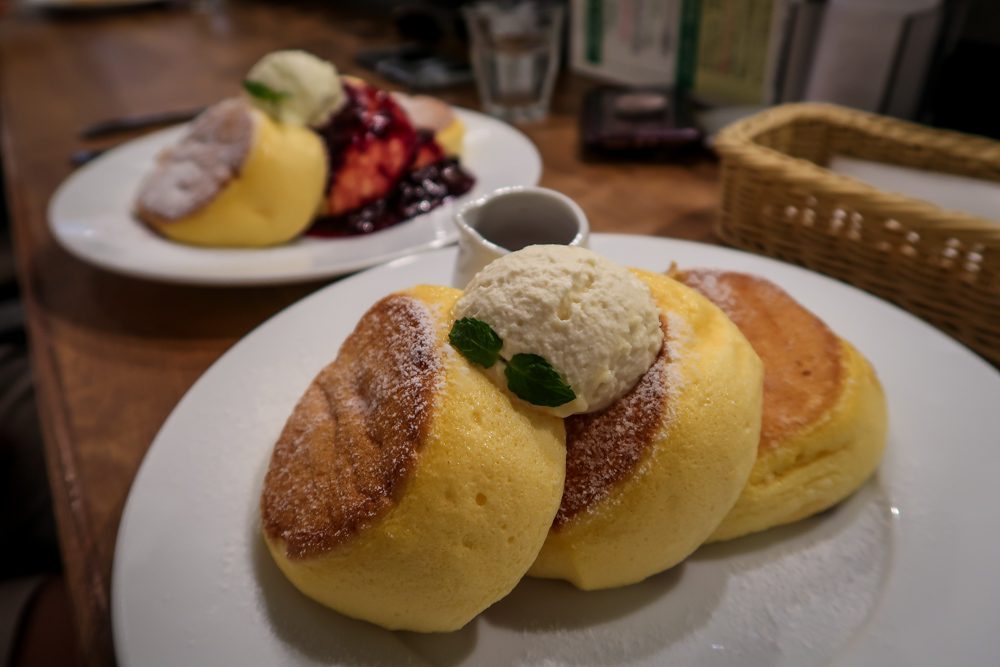
Fluffy soufflé pancakes is a trend in Japan that is blowing up.
After watching videos of them jiggling, I was super intrigued and had to give it a try. I read that the most famous chain, Gram Cafe, only serves a limited amount each day and only at certain times, so the lines can get intense.
Not in the mood for waiting (or so I thought), we decided to go to a (slightly) less famous chain — A Happy Pancake. They have a couple locations in Osaka, and they serve basically one thing: pancakes. (You can get an omelette WITH your pancake if you want).
We had to get a ticket and wait for about 25 minutes before being seated. On the menu it says to expect to wait at least 20 minutes for your pancake to be made to order, but I think ours came in about 15 minutes. It felt like longer because we were super hungry!
We ordered the original (served with whipped Manuka honey butter and caramel sauce) and one with mascarpone and berry compote.
Our opinion
We agreed that while the pancakes were good, they were overrated. Gasp. I know, you probably saw that one coming. Honestly, my favorite part of the whole thing was the whipped honey butter and mascarpone topping.
The pancakes themselves had a nice enough texture. Almost melt-in-your-mouth, a little more “bready”, but there wasn’t much flavor. Not really sweet. Not really anything.
The caramel sauce was more like simple syrup with a caramel “flavor”, like the shots they put in your coffee. A watery consistency and unbearably sweet. The berry compote was okay, but tasted a bit like frozen berries and too much sugar.
I’m not selling it, am I? Don’t get me wrong, it was good, just not great. Or worth the hype, the wait, and $23 we paid for 2 plates of pancakes.
They are still interesting to try if you have time to wait, but if you miss it don’t be too bummed.
Worth the hype? Nah… Try them if you have the time, but in all honesty, we thought they were overrated and not worth the long lines.
Bonus: location-dependent Japanese food
You’ll find many regional specialties around Japan. Here are just two that you should try if you are in the area!
38. Ōwakudani Black Egg
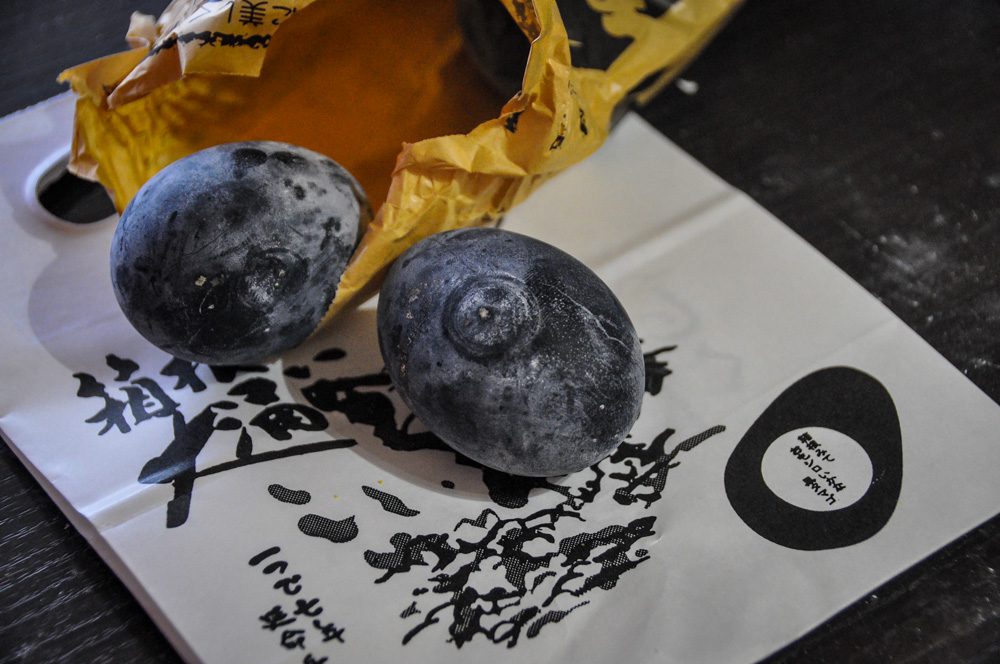
The small town of Hakone is known for views of Mount Fuji as well as an abundance of hot springs. In fact, the nearby valley is called Owakudani, which translates to “Great Boiling Valley”.
You can reach the famed hot springs by taking the aerial tram or hiking up a roughly 1 km trail. On a clear day, you’ll see spectacular views of iconic Mt. Fuji, and you’ll also see black eggs being sold. Don’t worry — they are not rotten!
The shell of these eggs turn black after being boiled in the sulfur and iron rich waters of the Owakudani hot springs.
They are regular chicken eggs and once you crack them open, they look like regular hard boiled eggs and taste the same (although you’ll likely detect a slight sulfur smell). Legend has it that these eggs, called kuro-tamago by locals, add 7 years to your life.
Eggs are sold in groups of five for ¥500. You’ll also see black rice cakes for sale that mimic the shape of the eggs and even have a yellow filling!
You can try these unique, peculiar eggs on a day trip from Tokyo to Hakone.
39. Deep-fried maple leaves
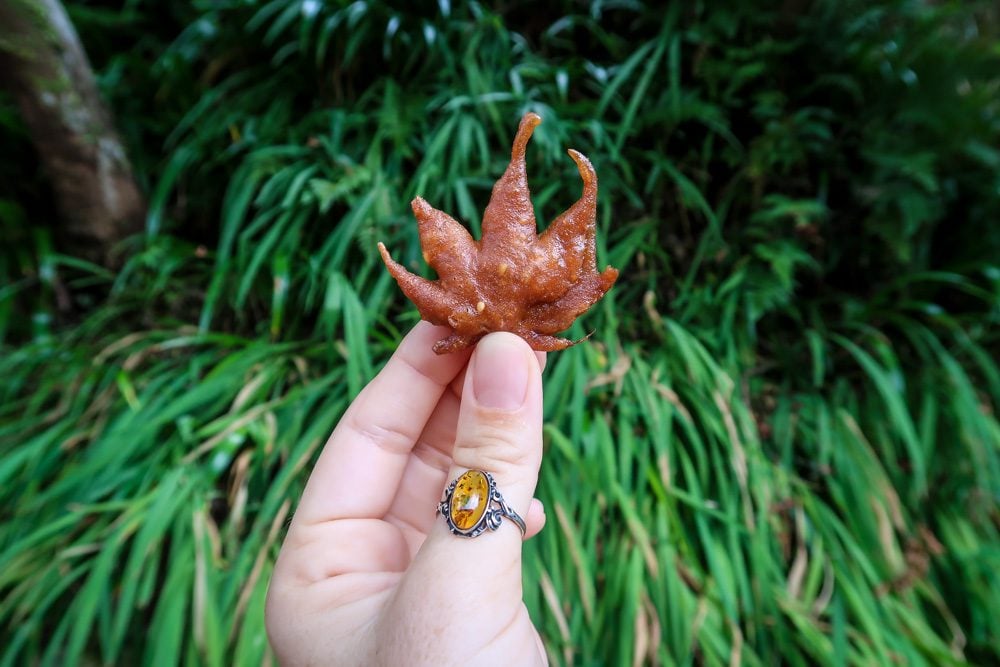
If you’re in Osaka and are craving a dose of nature, make the 45-minute journey to the northern outskirts of the city to Minoo Park. You’ll be able to breathe the fresh air, cool off in the mist of Minoo Falls, and try this park’s culinary specialty: deep-fried maple leaves, or momiji!
Minoo Park is full of maple trees, and local merchants will harvest young leaves from said trees and dry them out for a year. They are then dipped in a slightly sweet batter before being deep-fried for an iconic snack that you can only get in this park.
So what do they taste like exactly? Not much, really. You can’t really taste the leaf, but instead the batter is barely sweet and super crunchy — almost like a waffle cone. When you bite into one, you can see some of the leaf’s veins remain, but it isn’t unpleasant.
Vendors line the path from the train station to just before the waterfall, so find one that is frying them fresh and allows photos (some don’t). They are typically sold in bags that are priced by weight, starting at 200 – 300 yen.
40. Gold leaf ice cream
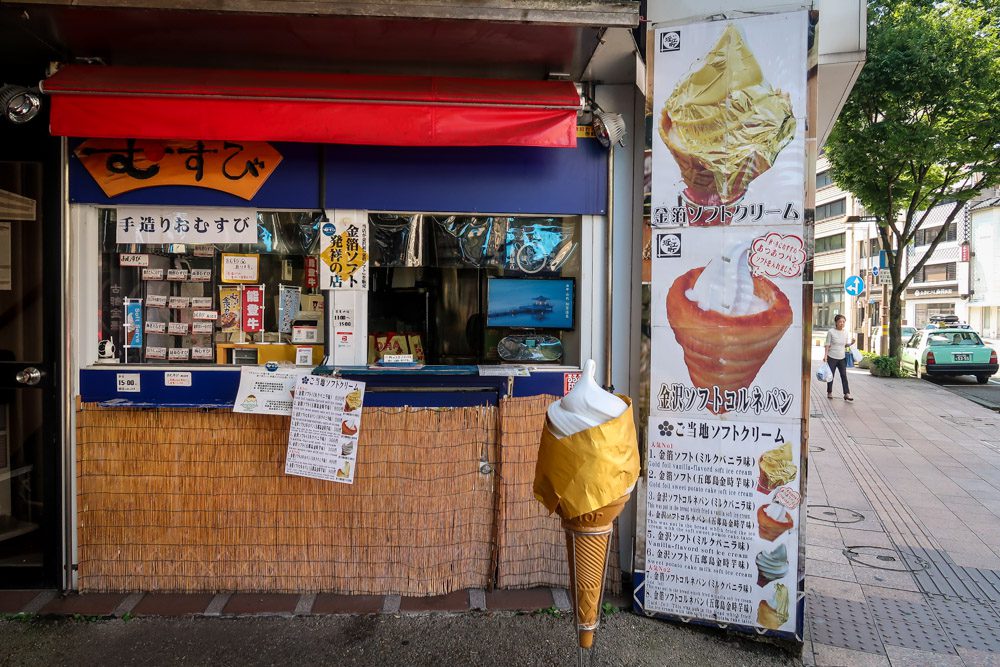
If you make the journey up to Kanazawa, you’ll notice lots of souvenirs with gold leaf, and for good reason: This seaside town was historically known for gold, and the reputation stuck.
You’ll find gold leaf souvenirs, gold leaf wrapped sushi, and yes, gold leaf ice cream.
I know what you’re thinking, and yes, gold leaf is totally safe to eat (when pure). So go ahead and indulge. Though don’t expect it to taste like anything really.
The average price we saw was ¥800 – ¥1000, and to be honest, we felt like it was pretty gimmicky. I mean, $10 USD for a regular soft serve cone with a shiny sheet on top?! It would make a cool picture, but we saved our money for other foods!
Beverages
Some of Japan’s beverages are just as famous as the cuisine itself. There should be a couple drinks in this list that you recognize, and probably even more that you don’t!
41. Matcha
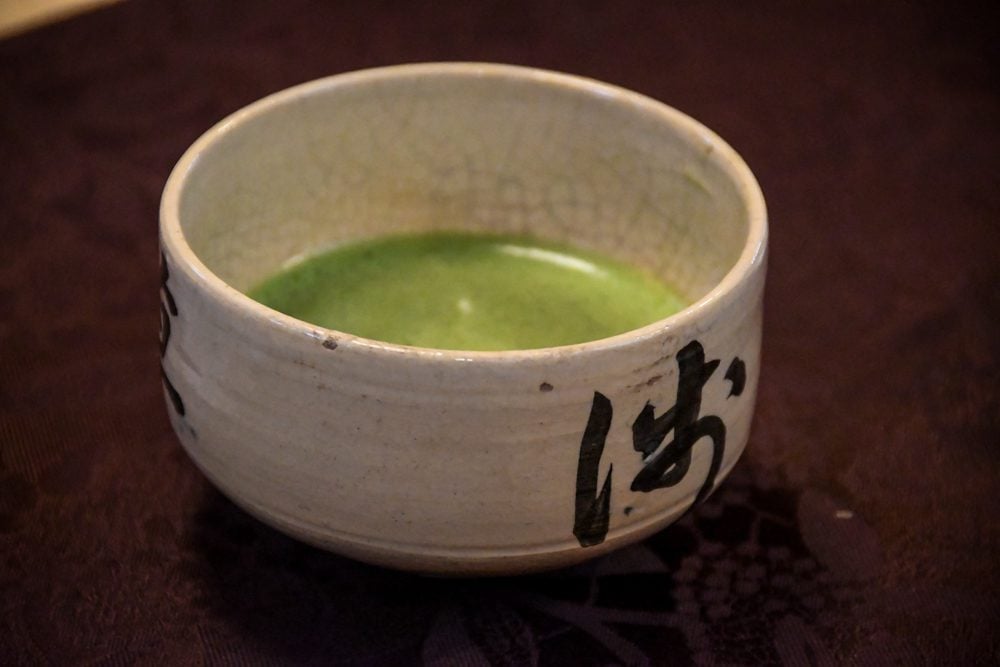
Matcha is a fine powder made of green tea leaves. When combined with hot water, it makes a earthy, slightly bitter tea.
With ample amounts of antioxidants, matcha is healthier than the bagged tea variety. In fact, matcha apparently has 10 times the health benefits of a cup of regularly brewed tea.
Go to any coffee shop in Japan and you’ll find a variety of matcha options, from plain with water to sweetened and mixed with frothed milk.
You may also want to add seeing a tea ceremony to your Japan bucket list to observe the spiritual and meditative process behind making a cup of matcha the traditional way.
Bonus: If you’re a big fan of tea, branch out from just matcha and sample other varieties: hojicha and sencha are stars that don’t get quite the worldwide praise as their green cousin, but are equally worth trying in Japan. And that’s just scraping the surface of Japan’s very deep tea culture.
42. Sake
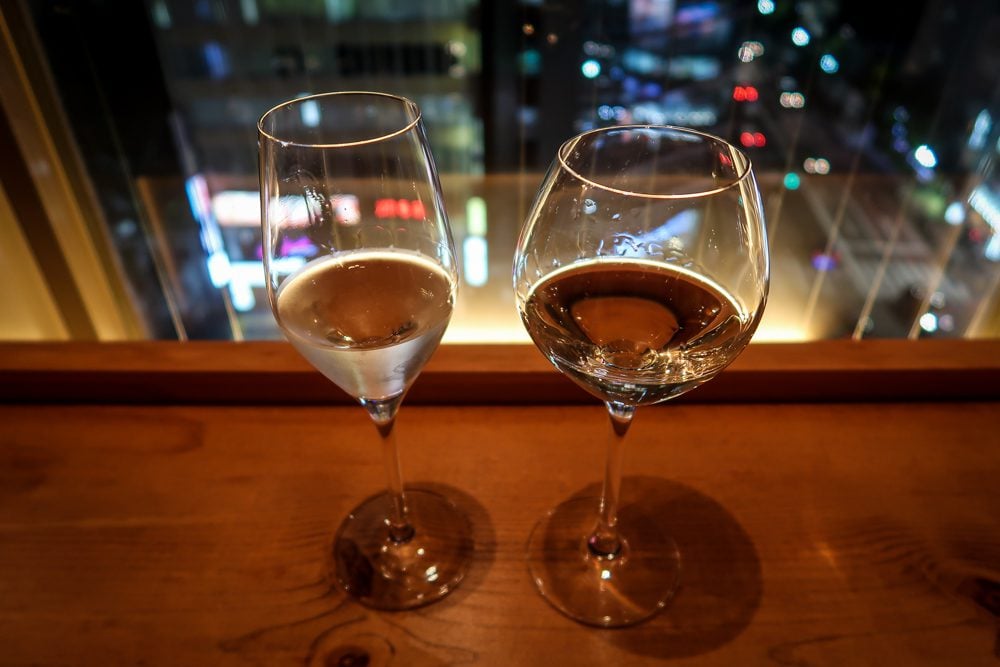
Sake, or rice wine, is one of the most famous exports from Japan.
Similar to wine made from grapes, there are different levels of sweetness, dryness, and aromatics. And if you (like us!) are a total sake newbie, it is a good idea to go to an establishment that will help you choose a sake based on your personal preferences.
If you’re really interested in sake, you might want to consider touring a sake brewery, which is usually free to do on your own. Sampling sake (and learning a bit about the different types) is also part of some of Arigato’s Food Tours and is a stop on Magical Trip’s Tokyo Bar Hopping Tour.
43. Shōchū
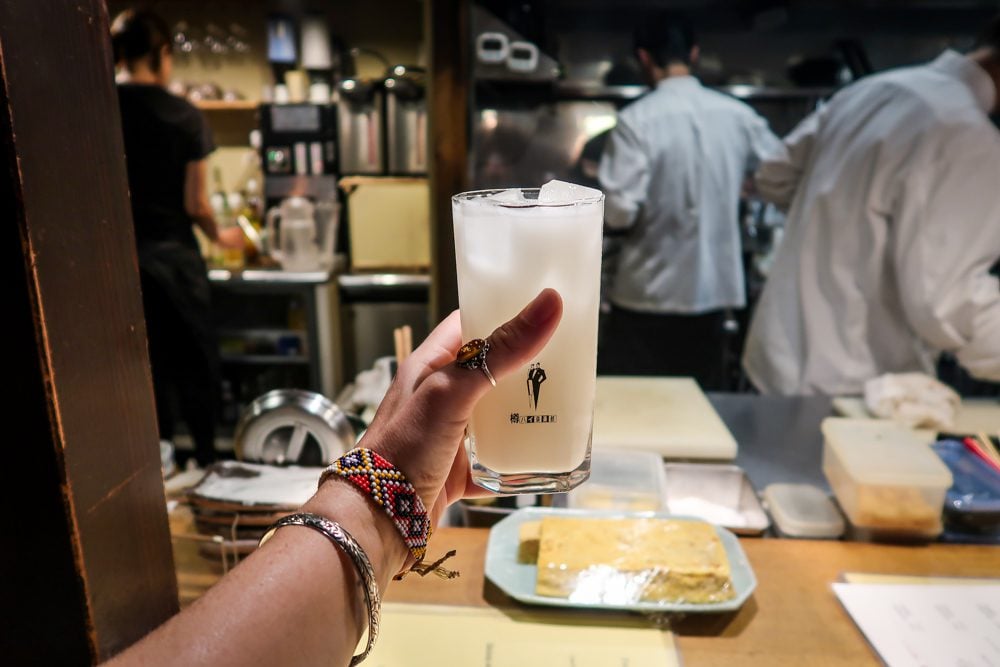
This clear liquor is distilled from rice, barley, sweet potatoes, buckwheat, or brown sugar, and is clear in color and tastes similar to vodka (or like Korean soju). It is stronger in alcohol than beer or sake, but usually has less than traditional hard liquor.
It can be served straight, on the rock or in a drink called chuhai (pictured above). This popular drink is made with shochu mixed with carbonated soda and a flavoring, such as lemon, grapefruit, plum (ume), or calpis (similar flavor to yogurt). It’s super refreshing on a hot day!
44. Umeshu (Plum Wine)
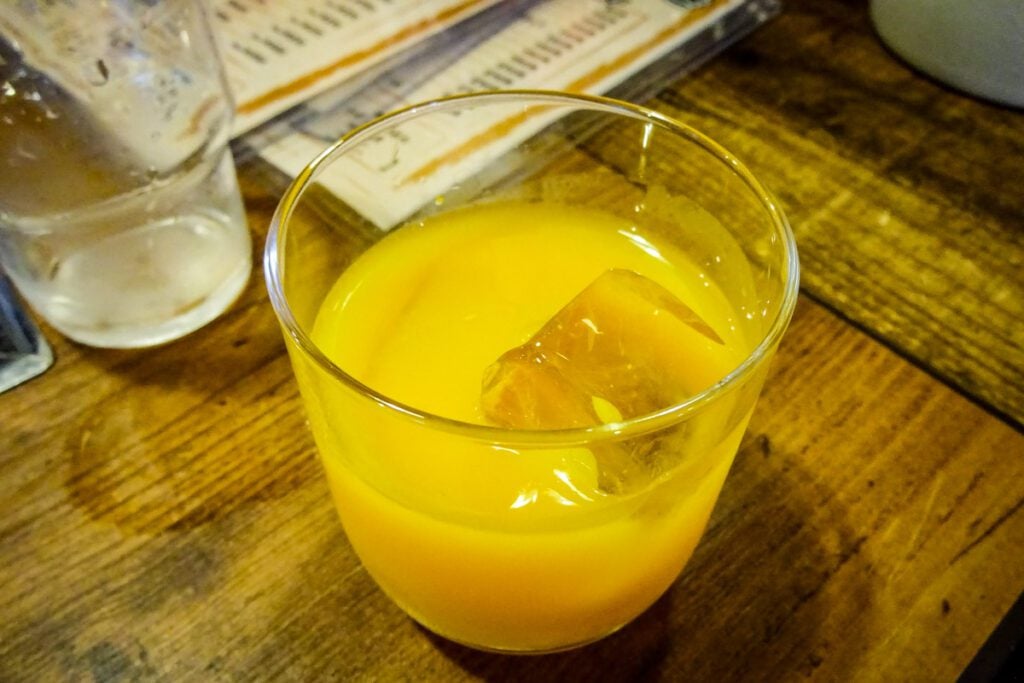
Unlike the name might suggest, this isn’t a wine at all, but instead is shochu (clear liquor) infused with ume (Japanese plum) and sugar. It makes for a sweet and slightly tangy drink that is served as is or mixed with soda water.
45. Japanese Whiskey
Oh, whiskey, you smooth devil.
If you’re a fan of the dark stuff, you’ll want to give it a try while in Japan. While Ireland, Scotland or America are typically the first countries that come to mind when people think of whiskey, Japan is making a name for itself.
Our recommendation: If you want a super cool place to try a whiskey cocktail, head to Osaka’s Bar Naruta. This hidden speakeasy is a bit tricky to find, but your efforts will be rewarded with skilled bartenders who handcraft drinks to order.
Just tell them you want whiskey, and name a few other flavors you like and watch them work their magic. Ben got a drink similar to an Old Fashioned with smoked ice. And the atmosphere is as top notch as the drinks (if you can get over the cigarette smoke!).
Japanese cuisine glossary: Words to know!
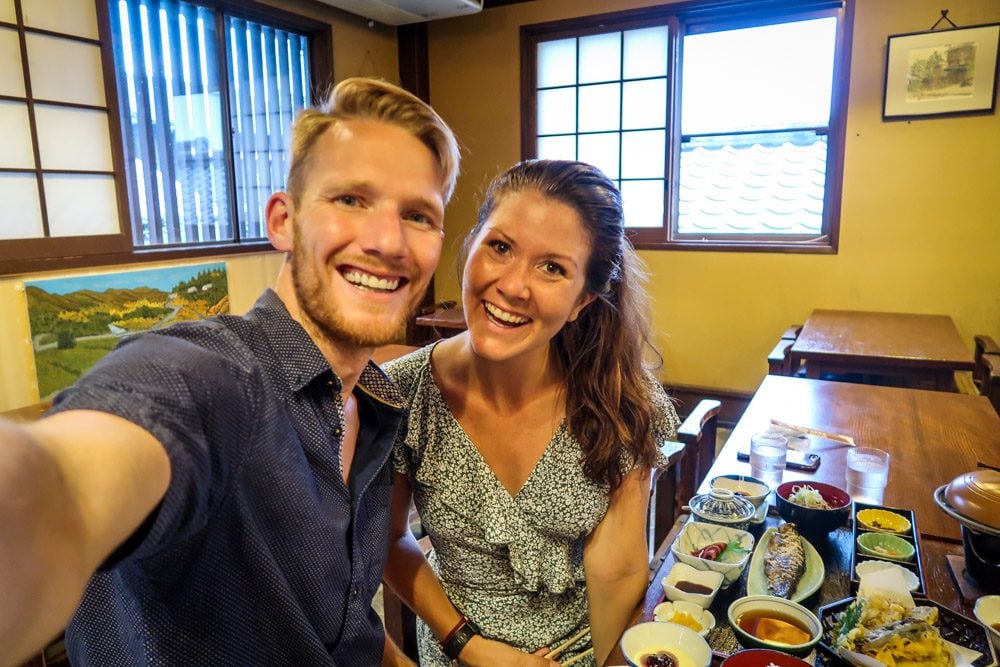
I don’t think I’m alone when I say Japanese cuisine can be confusing at first.
While traveling in Japan we have found that even if the menu was translated in English, there were still lots of words that left us scratching our heads.
Instead of sitting there and translating each word, we’ve created a super helpful list so you have all the definitions you need at your fingertips.
In the next section, you’ll find a free PDF download so you can print these words off and take them with you on your trip!
Cooking methods
- katsu = fried
- age = deep fried (karaage)
- yaki = cooked, usually fried (yakisoba)
- kushi = skewers (kushikatsu)
- tempura = battered and deep fried vegetables or meat
Types of dishes
- don = rice bowl (katsudon)
- bento = meal served in a box with compartments for different dishes
- kaiseki = traditional Japanese meal served with many small dishes, often served at higher end ryoken (traditional Japanese inn)
- izakaya = a casual bar/restaurant that serves small dishes and drinks; typically, izakayas are small and have limited seating. *More information on izakayas in the section below!
Types of meat & seafood
- niku = meat
- tori = bird, usually chicken
- wagu = word for all beef in Japan
- Kobe = beef raised in exclusive conditions; makes for expensive and very tender meat
- nori = seaweed (the sheets used in sushi)
- aonori= seaweed flakes
- sakana = fish
- shiifuudo = seafood
- maki = rolled (sushi), the word in Japanese for “sushi rolls” is makizushi
- maguro = tuna
- tako = octopus
- ebi = shrimp
- sake = salmon (yes, saké is also the famous Japanese rice wine)
- tamago = egg
Seasoning & miscellaneous
- shio = salt
- shoyu = soy sauce
- tamari = dark sauce used for dipping, similar flavor to soy sauce but typically a richer taste and a bit less salty; it also contains little to no wheat (but is usually not gluten-free, unless otherwise noted)
- ponzu = citrus and soy dipping sauce
- miso = fermented soybean paste
- There are different types of miso, usually varying based on how long it has been fermented. The longer the fermentation the stronger the flavor (red miso), and shorter fermentation times give it a lighter flavor (white miso).
- goma = sesame
- bonito = dried fish flakes, used for seasoning
- also called katsuobushi
- dashi = stock, usually has dried fish (bonito) as a component
- kombu = dried kelp; can be used to make a vegetarian version of dashi stock
- sake = rice wine
- mirin = slightly sweet rice wine, which is similar to sake but has a lower alcohol content and higher sugar content, making it great for cooking. It is used in making many sauces, including teriyaki.
- yakimeshi = Japanese fried rice
- wasabi = Japanese horseradish, light green in color and very strong flavor
- daikon = large white radish, often served shredded with sashimi
- umeboshi = pickled plum, which is salty and sour; sometimes served alongside meals or stuffed inside rice balls called onigiri
Free gift for you! If you haven’t already downloaded our (FREE!) Japanese food list we mentioned above, you’ll definitely want to now! It also includes this glossary of Japanese cuisine so you can take it along on your travels!
Interested in learning more? We’ve rounded up some practical Japanese words and phrases (that you can actually use!) for traveling in Japan.
Our favorite food experiences in Japan
One of our favorite things about traveling is experiencing the food. And in Japan, we did a lot more than just eating… We had a lot of foodie experiences that we’ll be talking about for years. Put some of these on your Japan bucket list!
Japanese cooking class
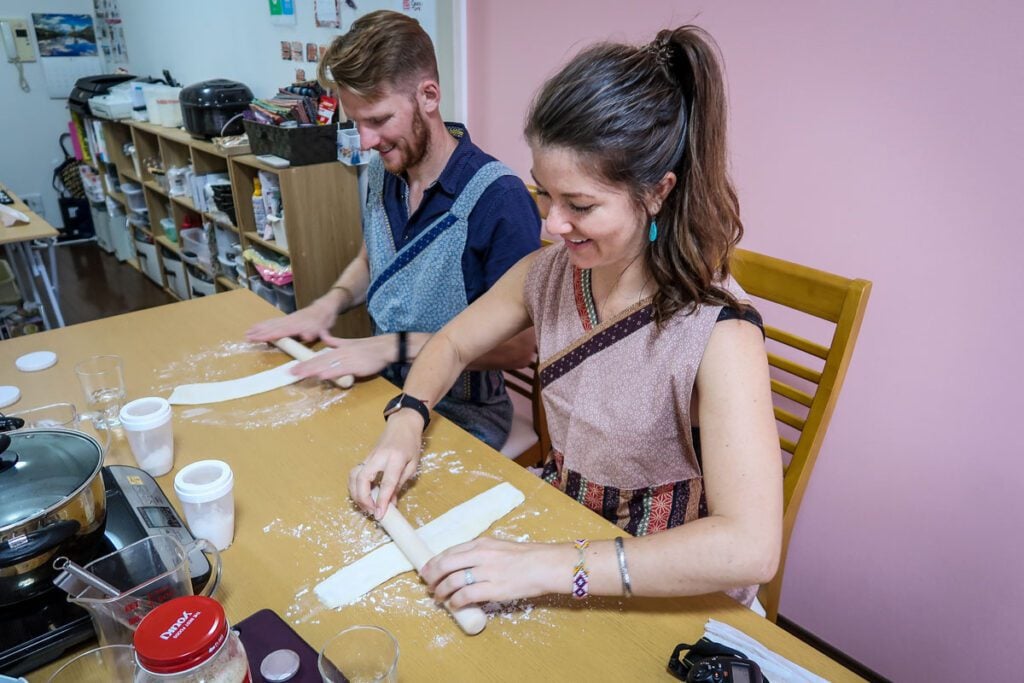
If you’ve been following our blog for a while, you might already know that we love taking cooking classes on our travels. We find it super rewarding to learn the process behind some of our favorite dishes, and we enjoy getting a different glimpse into a country’s cuisine.
Plus, we get to enjoy a delicious meal with a local, and typically we’re given recipes we can take home and attempt again (aka the Japanese souvenir that keeps on giving!).
We took two different cooking classes during our travels to Japan:
Japanese food tour
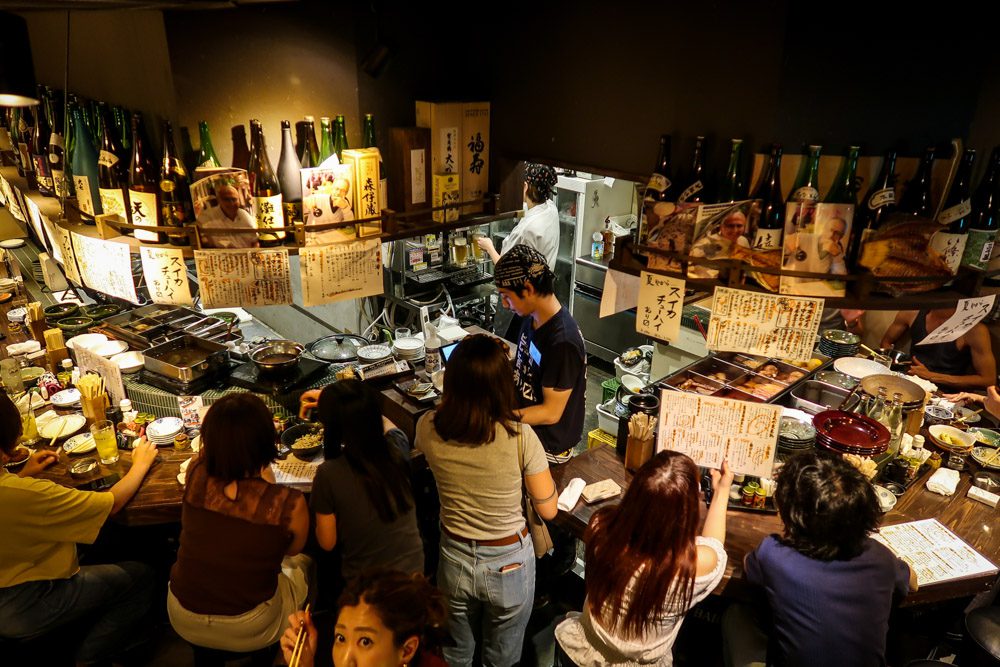
Recently, we’ve been getting into food tours on our travels. We’ve found the guides bring us to hidden spots we’d never find on our own and we learn a lot about the foodie culture that we’d otherwise miss.
We took 2 tours with Arigato Food Tours while in Japan, and we can see why they’re ranked the #1 food tour in the country.
We explored neighborhoods we might otherwise miss, and learned the history behind many foods.
If you were to choose only one, we’d recommend the tour in Osaka. The dishes we had were more exciting and the restaurants we visited were very unique, like we got to make our own takoyaki!
Note: In all honesty, we were expecting to have Japanese guides for these tours, but instead both were led by grad students who were also foreigners. They both spoke Japanese and had been living in the country for multiple years so they had a good handle on the culture and the cuisine.
Nagomi Visit
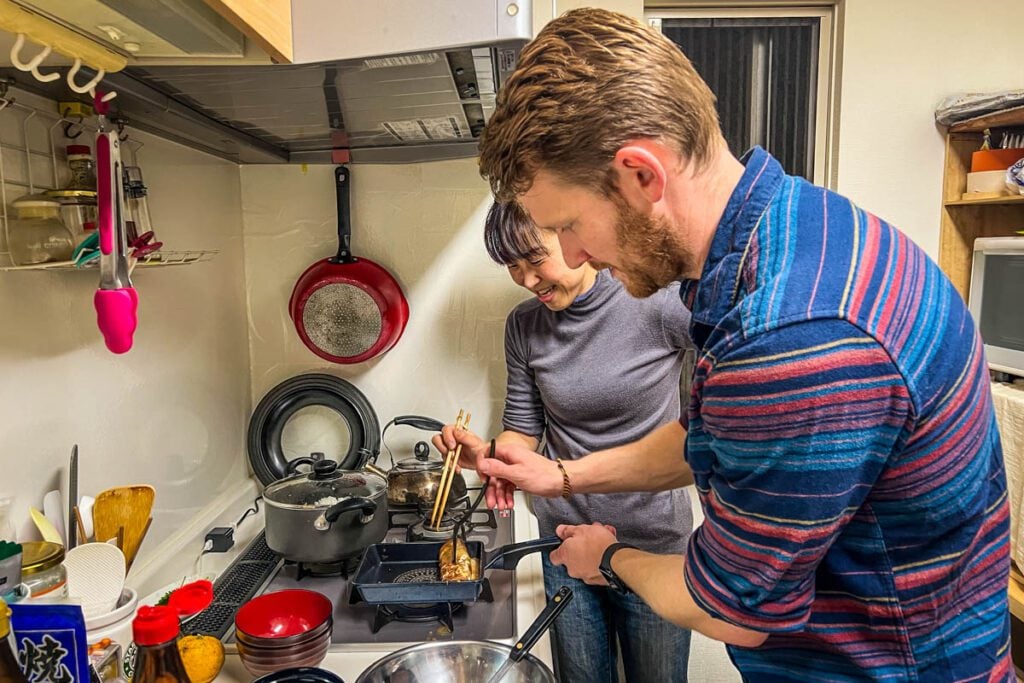
Ever wondered what it would be like to share a home-cooked meal with locals in Japan?
Nagomi Visit is a really cool program that essentially pairs you with a local family with whom you can enjoy a homemade meal. In addition to great food, it’s also a unique opportunity to get a glimpse into authentic Japanese culture and daily life.
On our most recent trip to Japan, we went to a local couple’s home in Tokyo for dinner through the Nagomi Visit program. It was absolutely one of the highlights of our trip, and we will definitely do it again!
We have a detailed guide that breaks down exactly how to plan your Nagomi Visit so that you can try this unique experience yourself:
Other memorable foodie experiences in Japan
There are lots of interesting cultural experiences for foodies that you can only find in Japan.
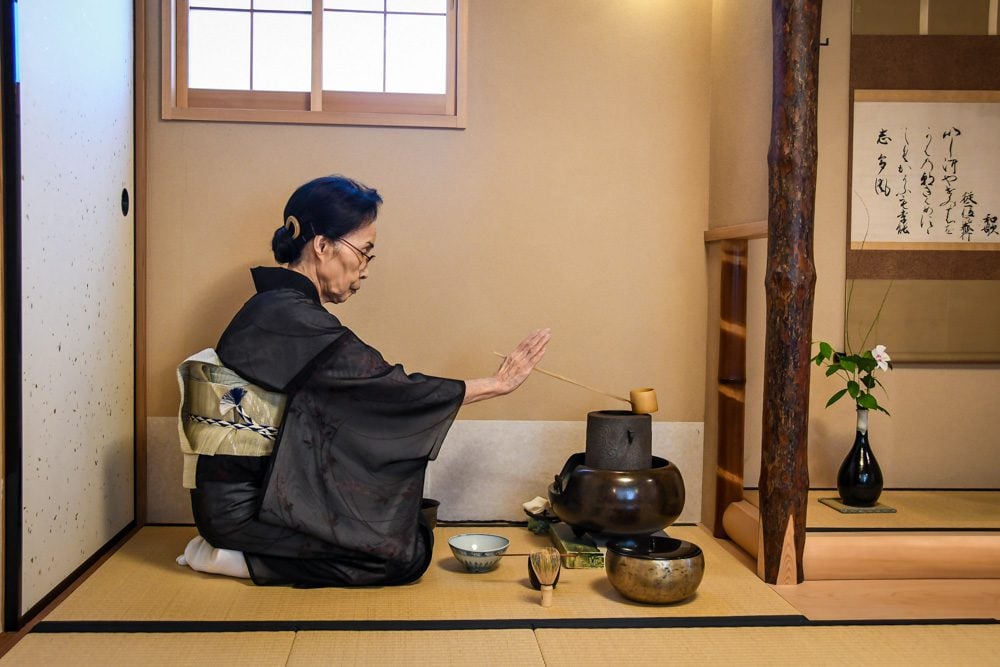
Eating in a “ramen booth”
Ichiran is world-famous, and according to signage in the restaurant, the private ramen booths that each patron sits at are intended to give you an intimate experience with your noodles, free of distraction. Definitely an experience! We thought the broth at Ichiran was some of the best we’ve had, but the noodles, while still great weren’t anything too special.
Check out the Fish Market
Having fresh sashimi at one of the country’s famous fish markets, like in Kanazawa or Tokyo, is a must for any sushi-lover!
Have drinks in Piss Alley
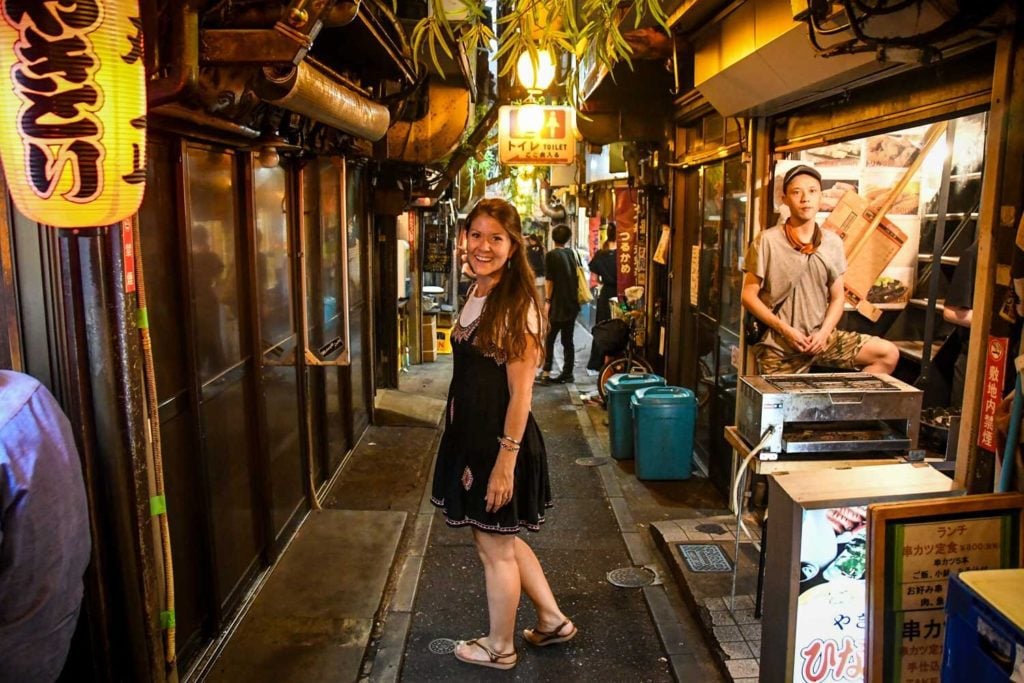
“Piss Alley” or Omoide Yokocho is a network of small alleyways near the west exit of Shinjuku Station in Tokyo. Our favorite night in Tokyo was spent hopping around between a couple of izakayas in this alley until we found one that we loved (and had a hard time leaving!).
Dine at Izakayas in Kanazawa
We went to many izakayas during our trip to Japan. The two that stand out for food and service were both in the seaside town of Kanazawa, and oh my goodness, were they something special!
And from the looks of it, Kanazawa is packed with incredible izakayas. (Note: our bills at each were around $50 USD for both of us, so these places may not be suitable for budget travelers.)
- Fuwari: Atmosphere and food were excellent. Make a reservation!
- Mammarumaru: Not quite as well known as Fuwari, but excellent food as well.
Enjoy Kanseki meals
We had 3 proper kanseki meals during our trip to Japan.
One was a vegan kanseki at our Koyasan temple stay, and the other was at a small family-run homestay along our Komodo Kodo trek where they served many fish dishes, which was fresh from the local river. The third was along the Nakasendo Trail, where they served a huge variety of local specialties.
All 3 experiences were incredible.
Dine at a theme restaurant

Japan is known for theme restaurants, and in big cities like Tokyo and Osaka, you’ll be spoiled with choices.
Arguably the most famous is the Robot Restaurant in Shinjuku (which sadly closed down in 2021). While we can’t say much for the food, the only way to describe the experience is utter insanity.
Touristy? Definitely. Weird? Hell yeah. But one of those experiences you just can’t have anywhere else in the world.
Attend a matcha ceremony
Observing a matcha ceremony is pretty interesting if you’re into tea and Japanese culture.
On our Arigato Food Tour, we stopped at a tea house where we were able to select our cup from their collection of prized antiques. Ben’s mug was 150 years old and crafted by a famous artist, and my cup was a whopping 300 years old!
We were able to observe the ritual of making matcha and then enjoy it in our own cup.
Grill your own meat at a Yakiniku restaurant
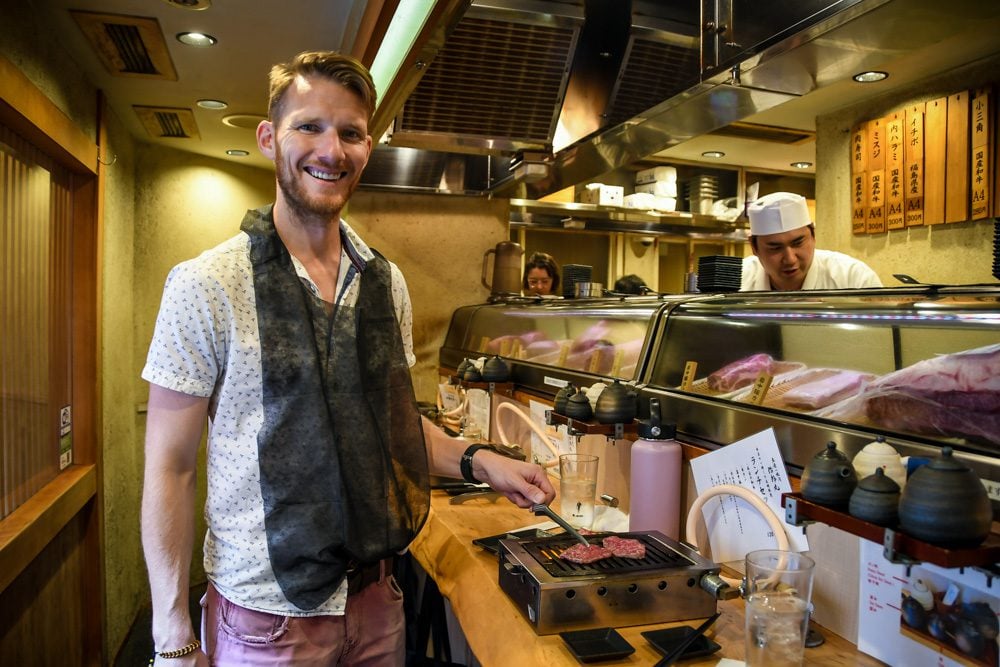
We loved being able to sample different grades of wagyu at Jiromaru Akihabara in Tokyo (for a very reasonable price!). And we learned that what they say is true — A5 wagyu is the best!
Try out a convenience store meal
It would be difficult to leave Japan without getting at least one convenience store meal. We had many, many more.
What to order in an izakaya
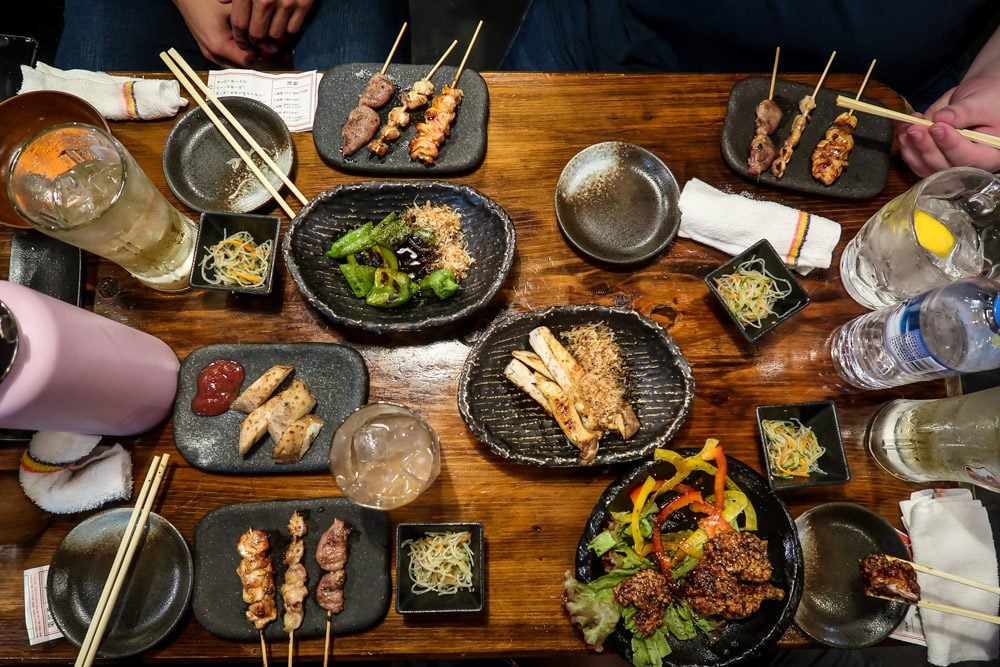
Here’s the thing: more often than not, the menus in izakayas are in Japanese.
You can use the photo function on the Google Translate app to see what each menu item is (a life-changing feature!). However, this can be difficult for handwritten menus, which are common in izakayas.
If all else fails and you just can’t read the menu, here are some items commonly found in izakayas that you can try to order. You’re welcome!
Food items
- Yakitori: skewers of meat and/or vegetables grilled over charcoal
- Edamame: Classic and healthy; good choice for vegetarians.
- Karaage: Japanese fried chicken, super crispy and often served with a lemon wedge.
- Kushikatsu: deep-fried skewers of meat and/or vegetables
Note: Some izakaya specialize in seafood, so instead of the dishes described above, you’ll find different types of fish.
Drink items
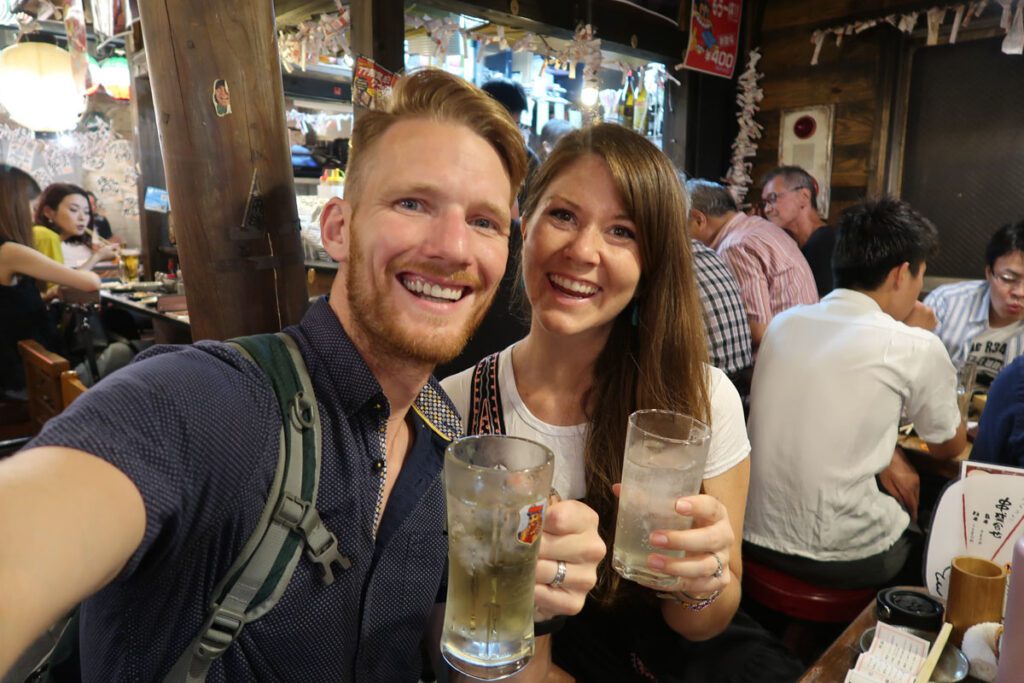
- Beer: if you like light beer, you can’t go wrong with this choice!
- Sake: Rice wine; some izakayas specialize in sake and will have many options to choose from.
- Sochu: kind of like vodka, this clear spirit is very similar to Korean soju and can be served straight, on the rocks, or with water to dilute it.
- Chuhai: sochu plus a flavored carbonated soda; the most popular flavor is lemon, but other fruit flavors like peach, ume (Japanes grape) and grapefruit, are usually available. Another flavor to try is calpis, which is similar to yogurt.
- Highball: whisky and carbonated water
- Gin and Tonic: Not exactly a traditional Japanese drink, but this is becoming more popular especially with younger generations.
- Umeshu: Plum wine; can be served as is or mixed with soda water to make it less sweet.
How much does an izakaya typically cost?
Don’t expect your bill to be cheap exactly. We are talking about Japan, after all. But izakayas are great places to sample a few different small dishes (totally my type of place!) for the same price you might pay for one larger meal.
Good to know: Some izakayas have a per person “cover charge”called otōshidai. (Most places we saw were around 300 yen per person). This includes a small (erm… tiny) surprise dish (otōshi) to sample.
Cost of food in Japan
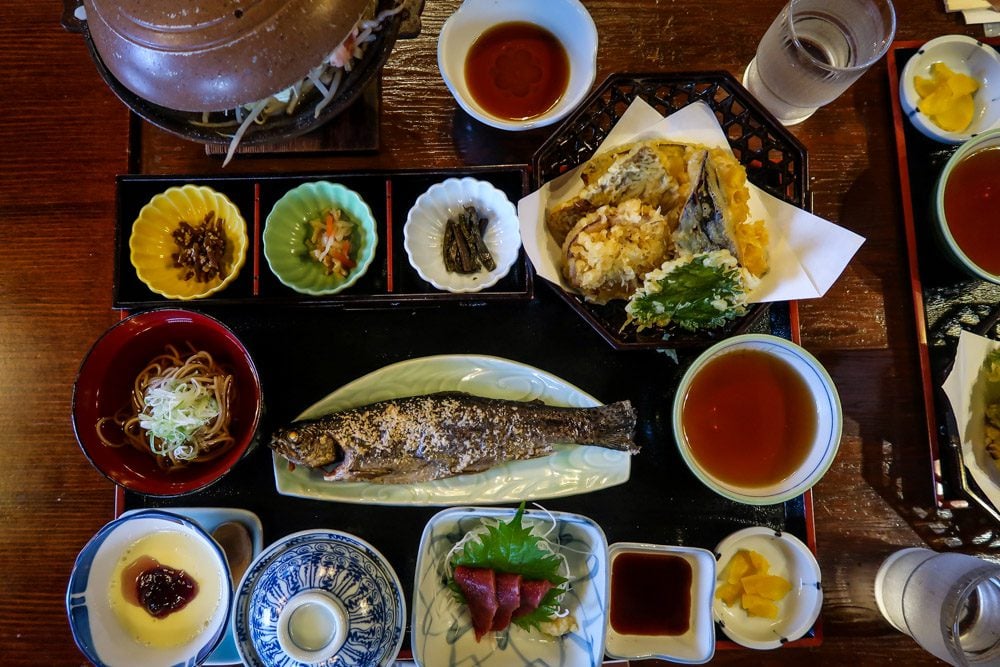
Japan is a notoriously expensive destination, and if you eat at high end restaurants for every meal, you’ll quickly blow your budget!
However, we found there were plenty of budget dining options in Japan as well. Many busy Japanese businessmen and women rely on quick and cheap food from convenience stores to get them through the day, and fast food is available throughout much of the country.
If you’re wondering just how much money to budget for food on your trip to Japan, this section will be particularly helpful to you as we’re about to break down some average costs, from the uber cheap convenience store eats to fine dining.
- Convenience Store Meal: 300-500 yen
- Fast Food: 500-1,000 yen
- Casual Restaurant: 1,000-1,500 yen
- Nicer Restaurant: 1,500-3,000 yen
You can certainly find fancier (and pricier!) meals than this, but this will be a good guide for the majority of your meals in Japan.
Traveling on a budget? We’ve broken down the cost of food in Japan in much greater detail (plus all other expenses you should expect) in our Japan budget article.
Allergies in Japan
If you have a specific allergy, it’s important to learn a bit of Japanese vocab to help communicate this to the restaurants you visit during your trip.
Let’s start with the Japanese word for allergy.
Allergy: Arerugī アレルギ
Say it aloud: It is pronounced a-RE-ru-ghee, which actually sounds kind of similar to the English version.
Now, let’s form a sentence…
“I have a [food item] allergy”.
Watashi wa [food item] arerugii ga arimasu.
私は [food item] アレルギーがあります
Here are a handful of common allergens that you can pop into this sentence:
- Shellfish: kai 貝
- Nuts: nattsu ナッツ
- Soy: daizu 大豆
- Eggs: tamago 卵
- Dairy: nyūseihin 乳製品
If you have a different allergy, be sure to look up the Japanese word.
More resources: Here is a website with free allergy cards translated into Japanese that you can show to restaurant staff. Just remember that you still will need to be cautious when dining out, as cross-contamination is possible.
Vegetarian & vegan in Japan
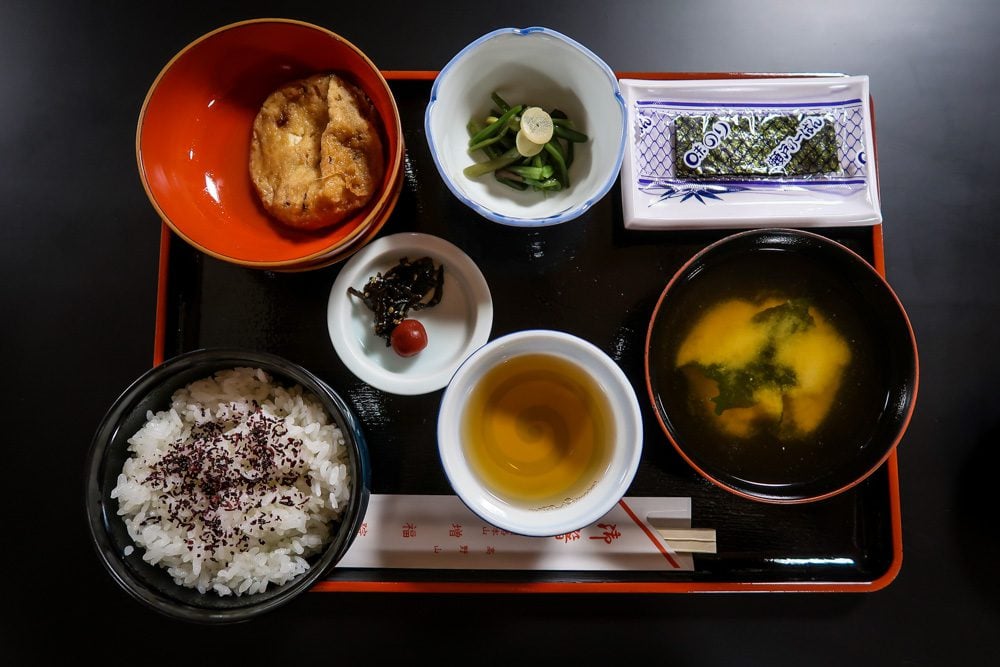
Traditional Japanese cuisine relies heavily on meat, fish and animal products, and vegetarianism is not exactly a part of Japanese culture. However, just like with many developed countries, it is becoming easier for vegetarians (and vegans) to enjoy the cuisine without compromising their eating habits.
Things to watch out for
Dairy products in general are not common in traditional Japanese cuisine, so you won’t have to worry too much about encountering them. Eggs are common in many Japanese dishes, as is a stock made from dried fish. Below, we’re going over some things to watch out for as you’re ordering food in Japan.
- Dried Bonito flakes: These pinkish flakes are sprinkled atop many dishes and are considered a “seasoning” of sorts. They are made from dried fish and are not suitable for those who don’t eat fish, however they are sometimes used in otherwise vegetarian dishes.
- Be sure to look on ingredient labels for this as well. We found bonito listed on snap pea crisps in Japan, which are usually vegetarian-friendly.
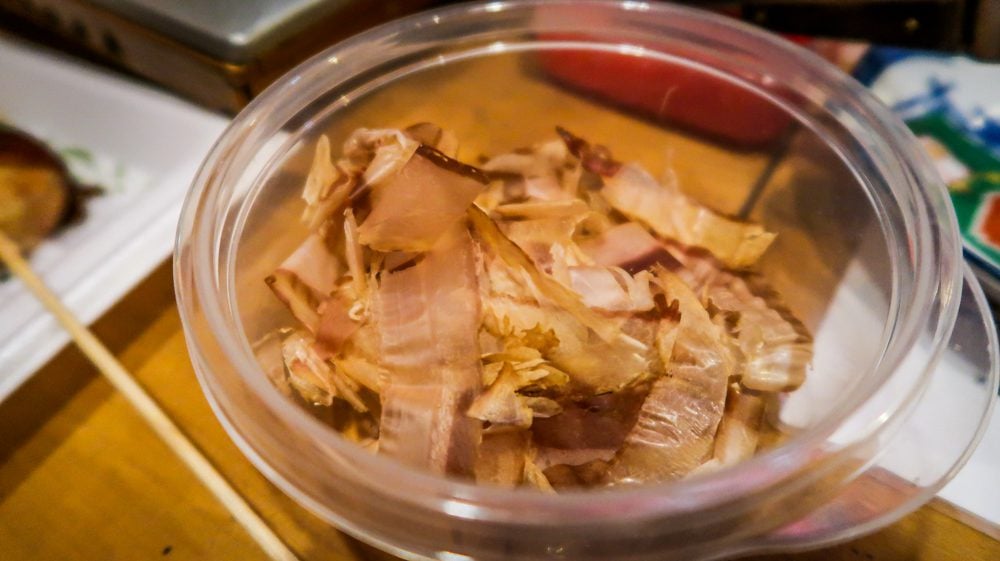
- Dashi: this stock is used in miso soup, as well as many other broth-based dishes and sauces. It is made with bonito flakes (read above). It’s even mixed into the batter of some grilled foods, like takoyaki and okonomiyaki. Many would-be vegetarian dishes contain dashi in the broth, making it unsuitable for those who don’t consume animal products.
- Eggs: If you can’t eat eggs, be sure to confirm the dishes you order don’t come with them, as they are commonly served soft boiled or scrambled and rolled.
Words & phrases for vegetarians to know
Below are some helpful Japanese words and phrases you can use at restaurants on your trip.
Vegetarian= Bejitarian ベジタリアン
- Pronounced: “bej-e-tar-ee-an”
- I am vegetarian= Watashi wa bejitarian desu
Vegan= Biigan ビーガン
- Pronounced: “bee-gan”
- I am vegan= Watashi wa biigan desu.
While it is becoming more common to hear these phrases in Japan, there still may be some confusion, especially in smaller towns.
Below are more specific ways to explain what you do not eat.
Words to know:
- niku= meat
- butaniku or pōku
- sakana= fish
- shiifuudo= seafood
- tamago= egg
- cheezu= cheese
- katsuobushi= bonito flakes (dried fish flakes used in broths and seasonings)
Nashi means “without”. Place the ingredient you cannot eat in front of the word “nashi” to communicate that you would like your meal served without this.
- Niku-nashi= without meat
- Sakana-nashi= without fish
Tabemasen means “I don’t eat”. Just like with “nashi,” place the food before “tabemasen” to indicate what you cannot eat.
- Niku tabemasen= I don’t eat meat.
- Sakana tabemasen= I don’t eat fish.
- Niku mo sakana mo tabemasen= I don’t eat meat or fish.
Safe foods for vegetarians & vegans in Japan
- Edamame
- Onigiri (there are varieties without meat or fish)
- Most desserts
- Soba, Udon, Ramen: Even the non-meat versions of these noodle dishes typically contain dashi in the broth or dipping sauce. So you will have to seek out establishments that advertise vegetarian versions of the dishes.
- You could order cold soba noodles and dip them in soy sauce instead of the dipping sauce that is served (which contains dashi).
- Tempura (use soy sauce for dipping instead of the tempura sauce, as it contains dashi)
- Kushikatsu
- Yakitori (vegetable skewers)
- Shabu-shabu: this hot pot dish has has lots of veggies you can choose to put inside, just skip the meat and ensure it is a miso or kombu (kelp) broth. Find a shabu-shabu restaurant that has special pricing for vegetarians since you won’t be eating the meat.
- Eggplant and Mushrooms are popular meat alternatives in Japan (you’ll also find tofu and seitan in some restaurants as meat-free options)
Vegetarian and vegan restaurants in Japan
We’re huge fans of using Happy Cow to find vegetarian restaurants around the world. When searching for veg restaurants in Japan, you’ll find it’s broken down by city, with the larger metropolises having more veg-friendly options.
It’s also worth noting that vegetarianism is practiced in Buddhist temples, so if you’re doing a temple stay during your trip, or are visiting a region that has strong religious ties, you’ll find more meat-free options for dining.
Koyasan Temple Stay Recommendation:
- Koyasan Zofukuin: Budget-friendly temple stay with excellent meals and beautiful facilities. We really enjoyed our time here.
- Bon-on-sha: Small artsy in the Koyasan town which serves up a plate of rotating vegetarian salads, casseroles and sides (with vegan options), all for 1000 yen (around $10 USD). They also have delicious coffee and cakes.
Gluten-free in Japan
If you’re gluten-free, I’ve got good news and bad news…
Let’s start with the bad and get it out of the way: Traveling to Japan as a celiac is difficult.
I ignorantly thought it would be quite easy to eat gluten-free in Japan because the cuisine is centered around rice. However, with soy sauce (which contains wheat!) being prevalent in many dishes, and cross-contamination being a major risk, celiacs must be very careful when traveling in Japan.
Ingredients common in Japanese cuisine you must NOT eat:
Wheat, soy sauce, barley, rye, malt, and seitan (a vegan faux meat)
The challenge is that there are many would-be gluten-free dishes that are not safe for celiacs to eat because soy sauce or some form of wheat flour is added.
Even foods that you’d think would be safe are off limits.
Here are some examples:
- Soba noodles, which are made from buckwheat (which is gluten-free!), are often blended with wheat flour, meaning the final product is not safe to eat.
- And tamari, which is tastes similar to soy sauce but is made without wheat, is not always gluten-free.
- On top of that, some sushi rice is made with a rice vinegar and barley malt blend, which – you guessed it – is not safe for celiacs.
I know this a major buzzkill for any celiacs trying to plan a trip to Japan. So by this point you must be ready for the good news, right?
It still is possible to travel to Japan as a celiac and enjoy the country’s cuisine with limitations. Tokyo, Osaka and other major cities are becoming more gluten-free aware, so there are an increasing number of options for travelers with restrictions.

Quick list of gluten-free Japanese foods that are safe for celiacs
This list is not comprehensive, but it should be a place to start.
- BBQ
- Yakitori (seasoned with salt instead of soy sauce)
- Edamame (as long as you ensure they are not boiling it in water that has been used for noodles)
- Sashimi
- Mochi
- Gluten-free Ramen (from a place that specializes in gluten-free ramen) Here are some gluten-free ramen shops in Tokyo:
- Gluten-Free T’s Kitchen
- Littlebird
- Soranoiro NIPPON (at “Ramen Street” inside Tokyo Station)
- Gluten-Free Ramen Shop Sinbusakiya
- Sake (stick to premium sake, which has strict regulations)
- Matcha
- Onigiri from 7-Eleven (some of them are safe, including the one filled with salmon)
- Shabu-shabu: check that the broth does not contain wheat, or ask for water broth to be safe. Skip the dipping sauces!
Tips for gluten-free travel in Japan
1. Print out an allergen card.
This way you can show the restaurant staff it written in Japanese.
Here is a free allergen card for celiacs traveling to Japan.
2. Learn the kanji
Learning the kanji, or characters used in Japanese writing, is important so you can check ingredient labels.
- wheat= 小麦
- soy sauce= 醤油
3. BYOT: Bring your own Tamari, that is!
Tamari is similar to soy sauce, but without wheat. That said, it is not always gluten-free, and is very difficult to find a safe version for celiacs in Japan.
Instead of risking it, bring your own from home. You can buy a bottle from the store (San-J is a good brand that is certified gluten-free) and pack it in your checked bag. Or you can bring small packets (like these).
4. Book a guesthouse with a kitchen
This way you can cook your own meals and ensure they are gluten-free.
5. Eat worry-free in Tokyo!
Little Bird Cafe in Tokyo is completely gluten-free and offers guests the chance to try traditional Japanese dishes without the worry of contamination.
6. BBQ is a good option
You’ll be given your own personal (clean) grill where you can cook raw (and unseasoned) meat to your liking. You can add salt and skip the sauces.
More resources on gluten-free travel in Japan
We’ve done a bit of research on the topic, but we’re not going to pretend we are experts on gluten-free eating. So instead of us trying to distill it all, we’re going to point you in the direction of a super helpful resource.
Jodi, from Legal Nomads, has traveled around the world as a celiac and she has put together some incredibly helpful guides to gluten-free eating around the world. Check out her gluten-free Japan guide, which includes a ton of helpful information!
Manners while eating in Japan
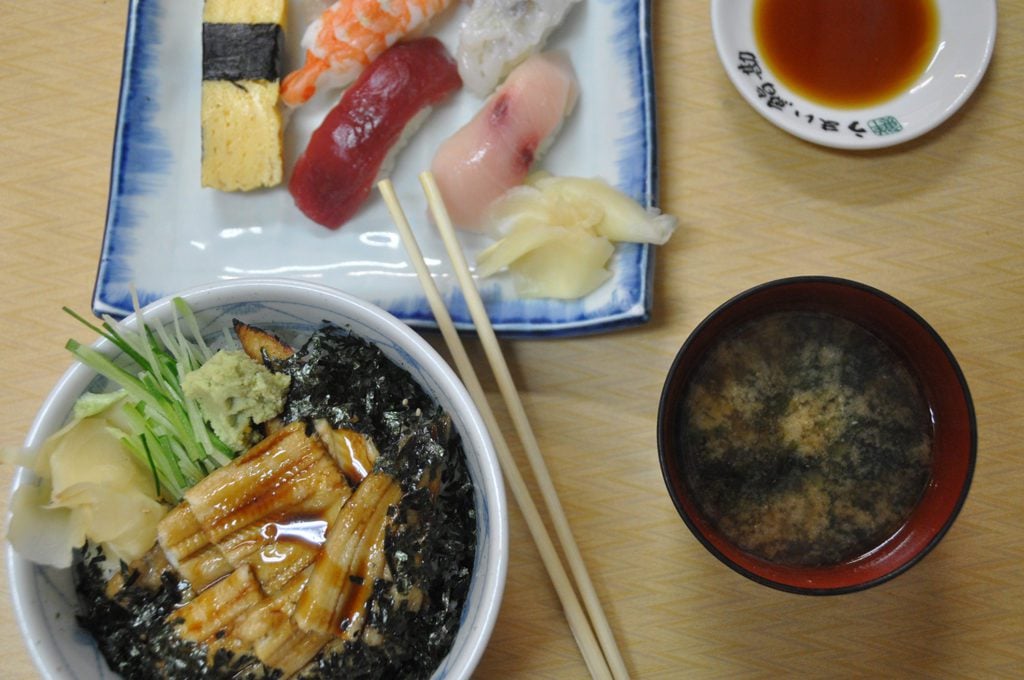
Japanese people are quite conscientious about minding their manners, and as a visitor you’re expected to follow the same rules. It’s understood if you occasionally slip up, but it is a good idea to read over these tips so you don’t end up in an embarrassing situation (we’ve definitely been there!).
- Don’t walk and eat: In Japan it’s seen as sloppy to eat while walking. Instead, find a place to sit and enjoy your snack before going on your way.
- Remove your shoes if necessary: Some restaurants will have a shoe rack at their entrance. If this is the case, it is a signal to remove your shoes and to go barefoot.
- Do not use the oshibori to wipe the sweat from your brow. We made this mistake during a sweltering August day and learned it is considered very rude.
- Me mindful of your chopsticks: When using chopsticks, it’s important to know a couple of taboos.
- Don’t tip: Tipping is not part of Japanese culture, so save your yen and don’t leave a tip. In some cases, it can even be taken as a slight insult.
→ Read about Japanese table manners in more detail in our article about Japanese etiquette.
Plan your trip to Japan
After 3 trips (and counting!), we’ve fallen head over heels for Japan—and we’ve created TONS of resources to help you plan your dream trip. Start with our Ultimate Japan Travel Guide and be sure to check out these helpful articles:
- First time? Our Japan Trip Planner walks you through everything you need to know.
- Use our Japan Rail Pass guide to determine if getting a train pass is optimal for your trip.
- Here’s our curated list of the best things to do in Japan—from iconic sights to once-in-a-lifetime experiences.
- Not sure where to go? Our Japan itinerary ideas will help you map it all out.
- Foodies, rejoice! This guide to what to eat in Japan will have you drooling before you land.
- This guide to what to wear in Japan (and what not to wear) will help you blend in.
- Use our ultimate Japan Packing List to make sure you don’t forget anything.
- Before you go, brush up on these essential Japan travel tips (including major do’s and don’ts!).
- Avoid awkward moments by brushing up on Japanese etiquette.
Still have questions? Drop us a comment—we LOVE helping travelers plan unforgettable trips to Japan!
Perfect Japan itinerary
Want the perfect itinerary planned for you?

If you don’t have a ton of time to spend planning your Japan itinerary (or you just don’t find travel planning fun), we’ve got something you might be interested in…
We created the ultimate done-for-you Japan itinerary that is packed full of all sorts of tips we’ve gathered from 3 trips to Japan as well as literally hundreds of hours of research (no exaggeration).
We have both an off-the-beaten path route as well as a classic itinerary that hits the top attractions (perfect for your first visit to Japan!).
Don’t miss your chance to grab our Japan packing list!
This FREE PDF download includes everything you’re going to want to pack for your Japan trip, including what NOT to bring, plus tons of insider tips!
Just enter your email and we’ll immediately send you access instructions!
Save this article for later on Pinterest!
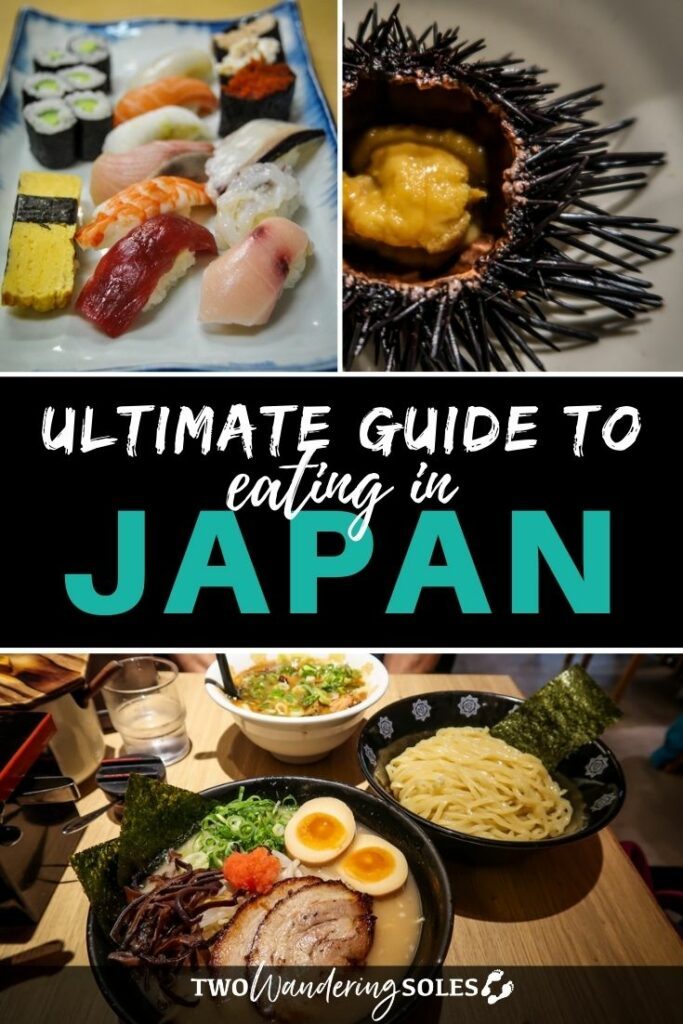
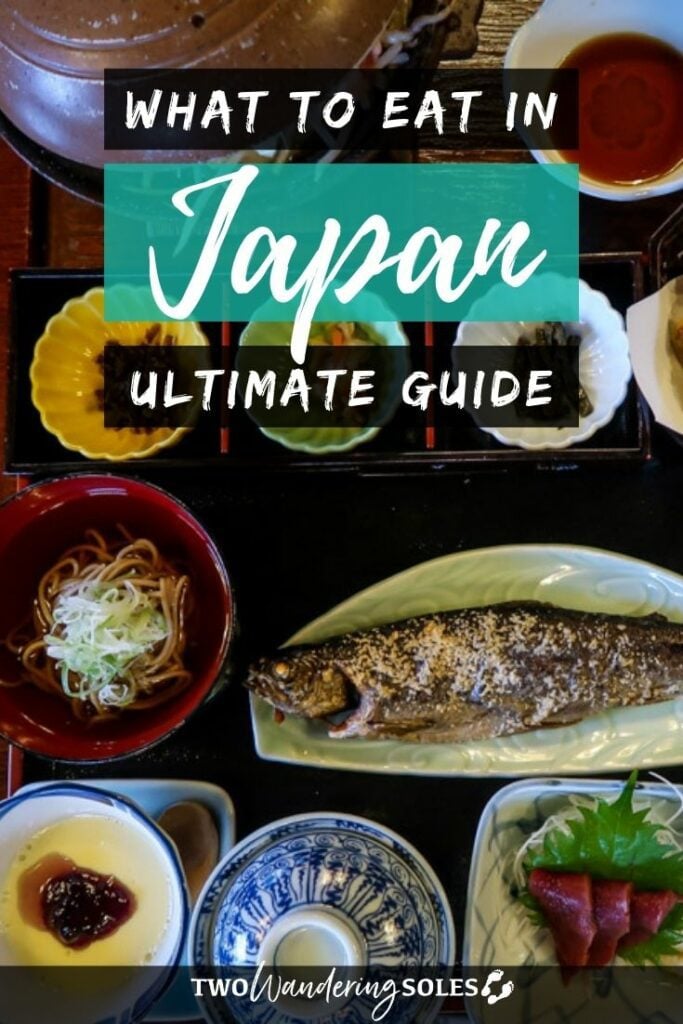
We want to hear from you!
What dish sounds the most interesting to you? Anything you wouldn’t try? Have questions or foods you think we should add to this list?
Comment below and we’ll do our best to get back to you!


This article is very helpful!
Thanks for sharing
Thank you for such an informative blog. I wish you had more information about Vegetarian establishments in the main cities. Holy Cow is listing too many places.
Also more information on Buddhist Restaurants would be useful.
Thank you
Thanks
Thanks for sharing such valuable information.
That’s so wonderful! I have a plan to visit Japan next month for business purpose and I was looking for some similar posts. I am glad I found your post. Thanks.
This article is awesome but I have to point out that Kyoto is NOT in Hyogo. Kyoto is in Kyoto Prefecture. Hyogo is the one next to it!